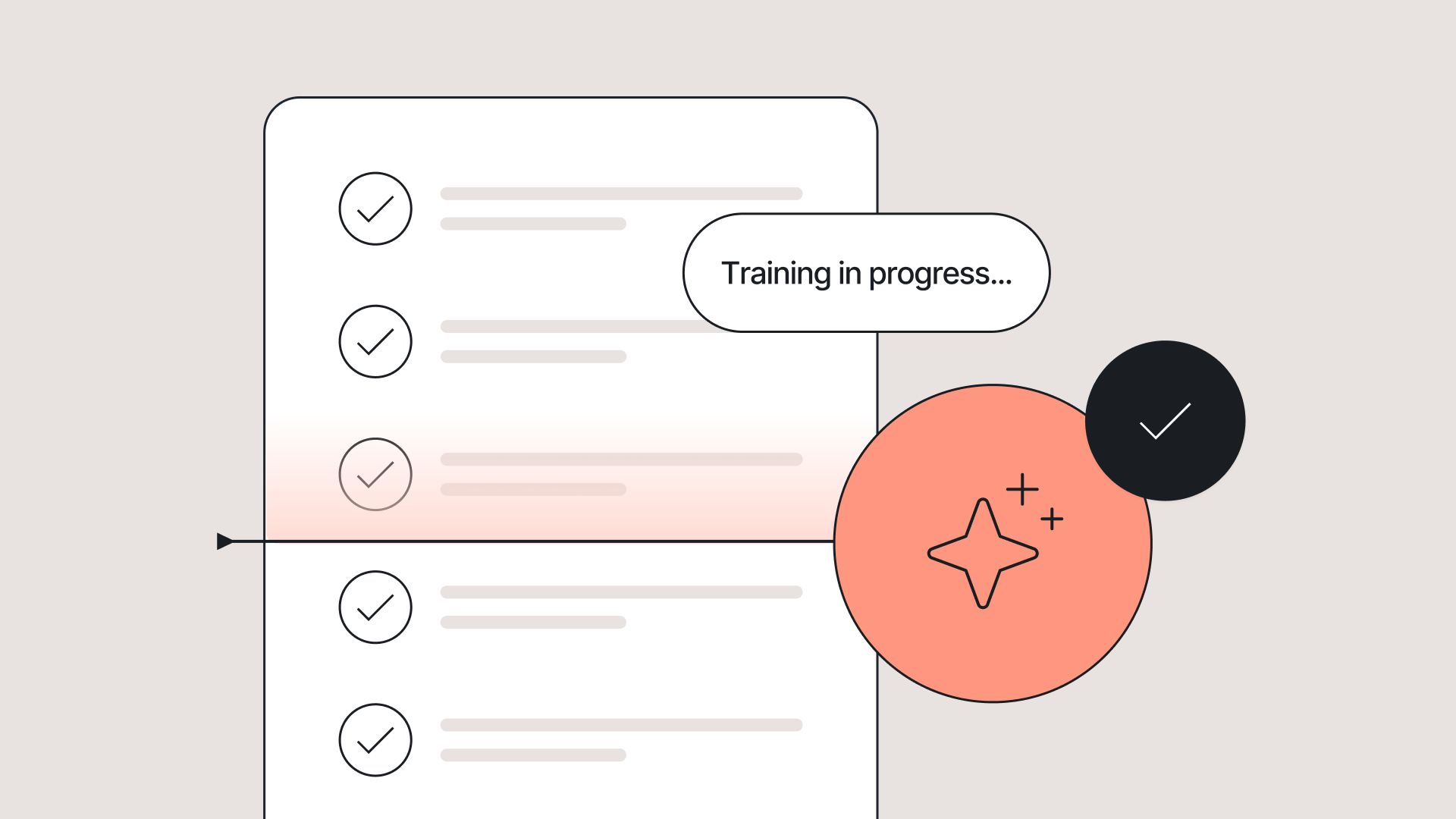
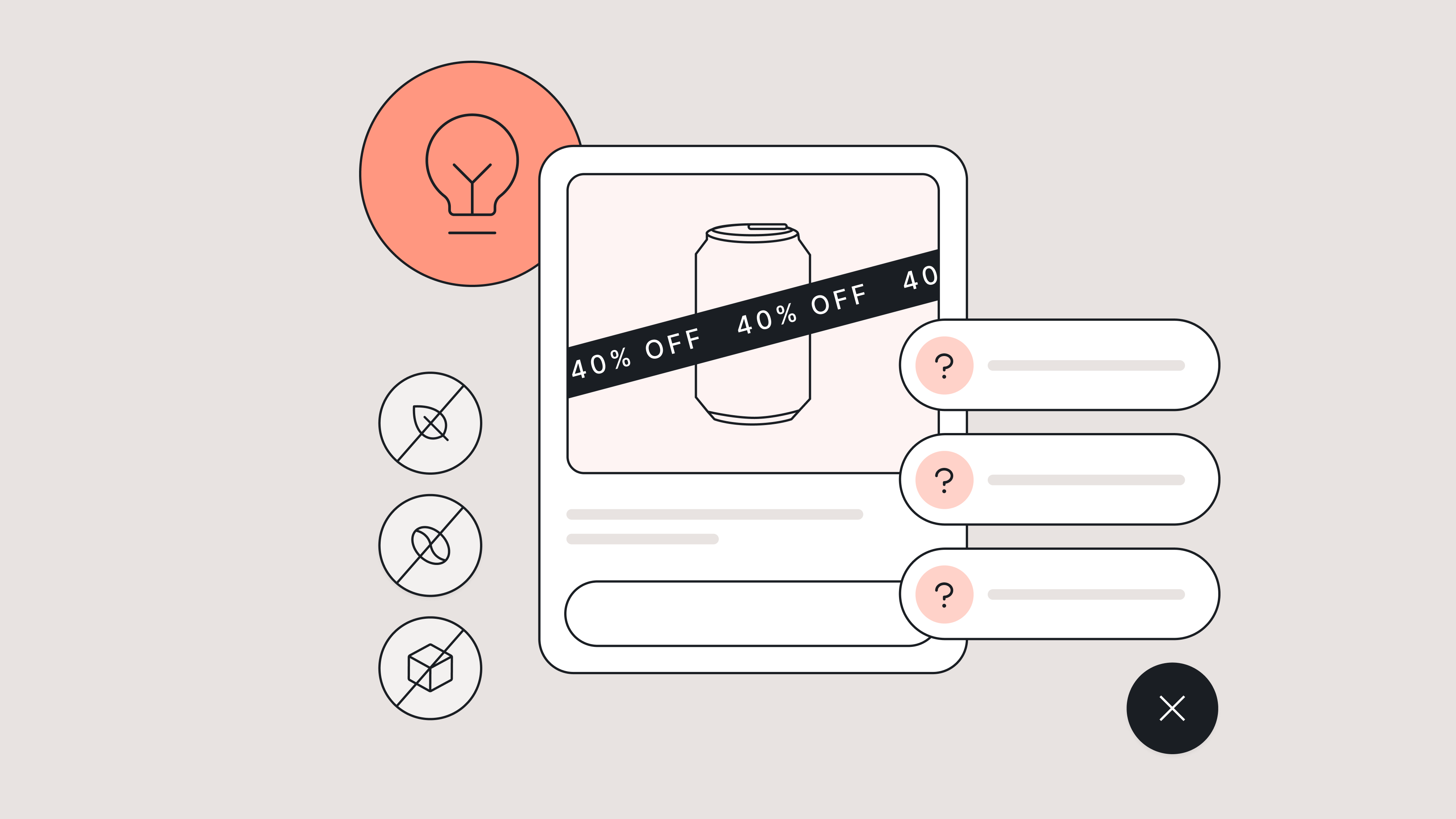

How Food & Beverage Brands Can Level Up Self-Service Before BFCM
TL;DR:
- Most food & beverage support tickets during BFCM are predictable. Subscription cancellations, WISMO, and product questions make up the bulk—so prep answers ahead of time.
- Proactive CX site updates can drastically cut down repetitive tickets. Add ingredient lists, cooking instructions, and clear refund policies to product pages and FAQs.
- FAQ pages should go deep, not just broad. Answer hyper-specific questions like “Will this break my fast?” to help customers self-serve without hesitation.
- Transparency about stock reduces confusion and cart abandonment. Show inventory levels, set up waitlists, and clearly state cancellation windows.
In 2024, Shopify merchants drove $11.5 billion in sales over Black Friday Cyber Monday. Now, BFCM is quickly approaching, with some brands and major retailers already hosting sales.
If you’re feeling late to prepare for the season or want to maximize the number of sales you’ll make, we’ll cover how food and beverage CX teams can serve up better self-serve resources for this year’s BFCM.
Learn how to answer and deflect customers’ top questions before they’re escalated to your support team.
💡 Your guide to everything peak season → The Gorgias BFCM Hub
Handling BFCM as a food & beverage brand
During busy seasons like BFCM and beyond, staying on top of routine customer asks can be an extreme challenge.
“Every founder thinks BFCM is the highest peak feeling of nervousness,” says Ron Shah, CEO and Co-founder of supplement brand Obvi.
“It’s a tough week. So anything that makes our team’s life easier instantly means we can focus more on things that need the time,” he continues.
Anticipating contact reasons and preparing methods (like automated responses, macros, and enabling an AI Agent) is something that can help. Below, find the top contact reasons for food and beverage companies in 2025.
Top contact reasons in the food & beverage industry
According to Gorgias proprietary data, the top reason customers reach out to brands in the food and beverage industry is to cancel a subscription (13%) followed by order status questions (9.1%).
Contact Reason |
% of Tickets |
|---|---|
🍽️ Subscription cancellation |
13% |
🚚 Order status (WISMO) |
9.1% |
❌ Order cancellation |
6.5% |
🥫 Product details |
5.7% |
🧃 Product availability |
4.1% |
⭐ Positive feedback |
3.9% |
7 ways to improve your self-serve resources before BFCM
- Add informative blurbs on product pages
- Craft additional help center and FAQ articles
- Automate responses with AI or Macros
- Get specific about product availability
- Provide order cancellation and refund policies upfront
- Add how-to information
- Build resources to help with buying decisions
1) Add informative blurbs on product pages
Because product detail queries represent 5.7% of contact reasons for the food and beverage industry, the more information you provide on your product pages, the better.
Include things like calorie content, nutritional information, and all ingredients.
For example, ready-to-heat meal company The Dinner Ladies includes a dropdown menu on each product page for further reading. Categories include serving instructions, a full ingredient list, allergens, nutritional information, and even a handy “size guide” that shows how many people the meal serves.
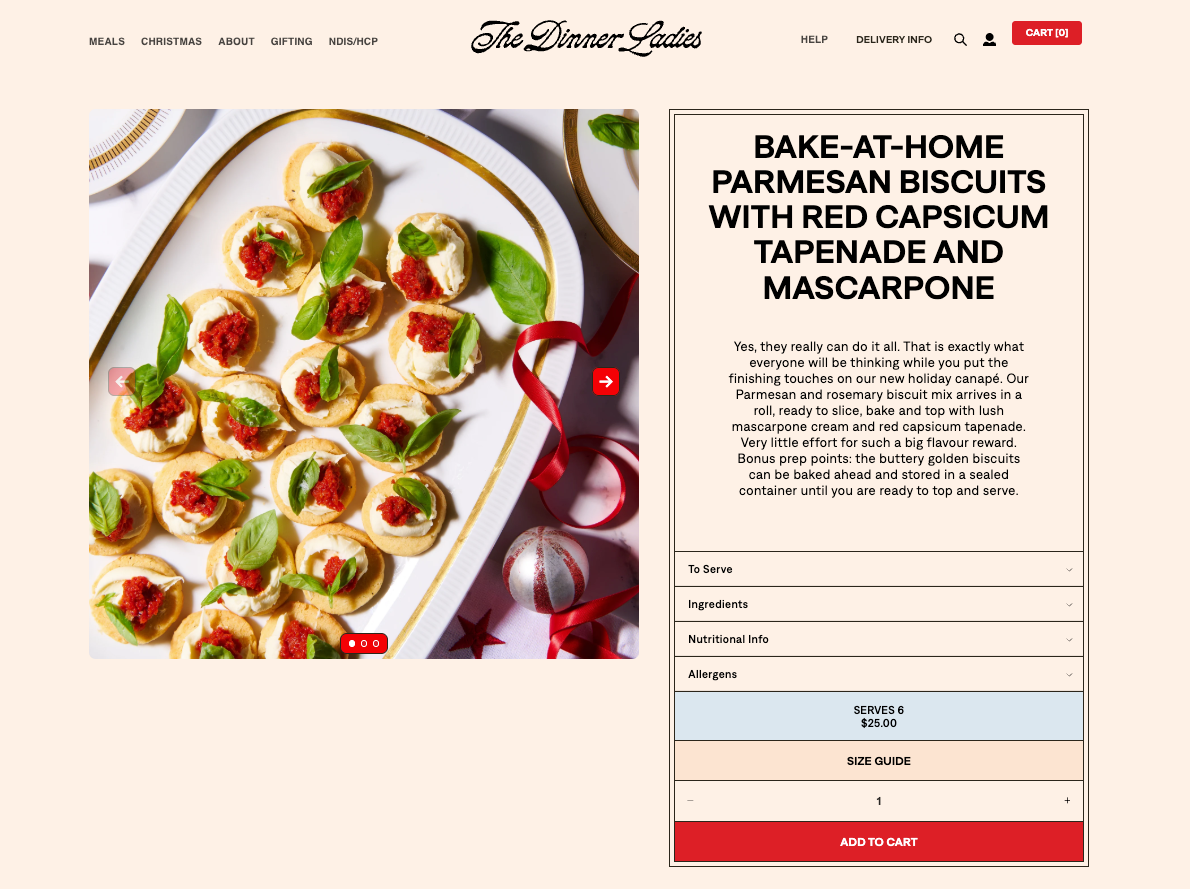
2) Craft additional Help Center and FAQ articles
FAQ pages make up the information hub of your website. They exist to provide customers with a way to get their questions answered without reaching out to you.
This includes information like how food should be stored, how long its shelf life is, delivery range, and serving instructions. FAQs can even direct customers toward finding out where their order is and what its status is.

In the context of BFCM, FAQs are all about deflecting repetitive questions away from your team and assisting shoppers in finding what they need faster.
That’s the strategy for German supplement brand mybacs.
“Our focus is to improve automations to make it easier for customers to self-handle their requests. This goes hand in hand with making our FAQs more comprehensive to give customers all the information they need,” says Alexander Grassmann, its Co-Founder & COO.
As you contemplate what to add to your FAQ page, remember that more information is usually better. That’s the approach Everyday Dose takes, answering even hyper-specific questions like, “Will it break my fast?” or “Do I have to use milk?”
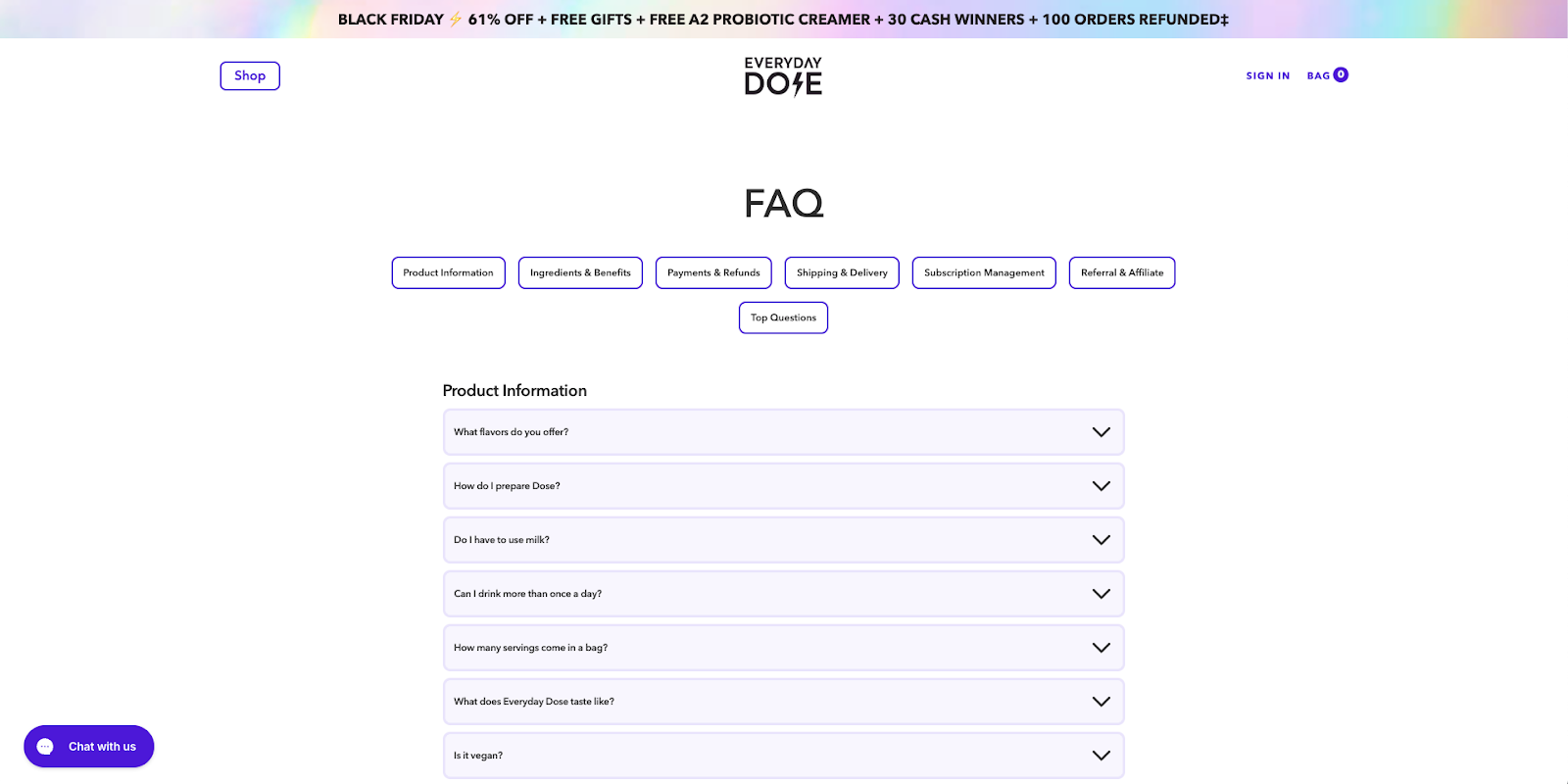
While the FAQs you choose to add will be specific to your products, peruse the top-notch food and bev FAQ pages below.
Time for some FAQ inspo:
- Juice Plus+ FAQ
- Everyday Dose FAQ
- Chamberlain Coffee FAQ
- Jurassic Fruit FAQ
- Rebel Cheese FAQ
- The Dinner Ladies FAQ
3) Automate responses with AI or macros
AI Agents and AI-powered Shopping Assistants are easy to set up and are extremely effective in handling customer interactions––especially during BFCM.
“I told our team we were going to onboard Gorgias AI Agent for BFCM, so a good portion of tickets would be handled automatically,” says Ron Shah, CEO and Co-founder at Obvi. “There was a huge sigh of relief knowing that customers were going to be taken care of.”
And, they’re getting smarter. AI Agent’s CSAT is just 0.6 points shy of human agents’ average CSAT score.
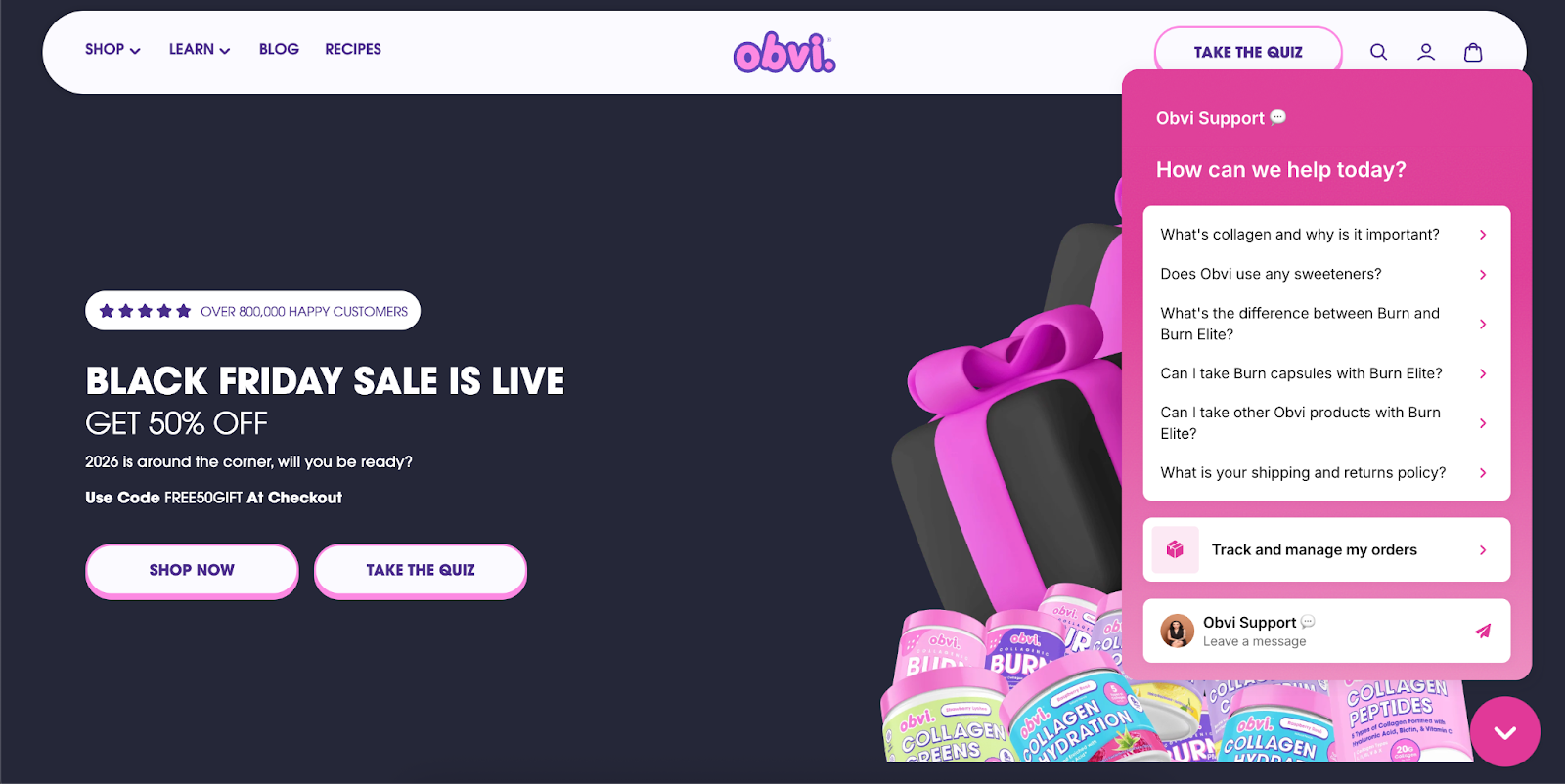
Here are the specific responses and use cases we recommend automating:
- WISMO (where is my order) inquiries
- Product related questions
- Returns
- Order issues
- Cancellations
- Discounts, including BFCM related
- Customer feedback
- Account management
- Collaboration requests
- Rerouting complex queries
Get your checklist here: How to prep for peak season: BFCM automation checklist
4) Get specific about product availability
With high price reductions often comes faster-than-usual sell out times. By offering transparency around item quantities, you can avoid frustrated or upset customers.
For example, you could show how many items are left under a certain threshold (e.g. “Only 10 items left”), or, like Rebel Cheese does, mention whether items have sold out in the past.
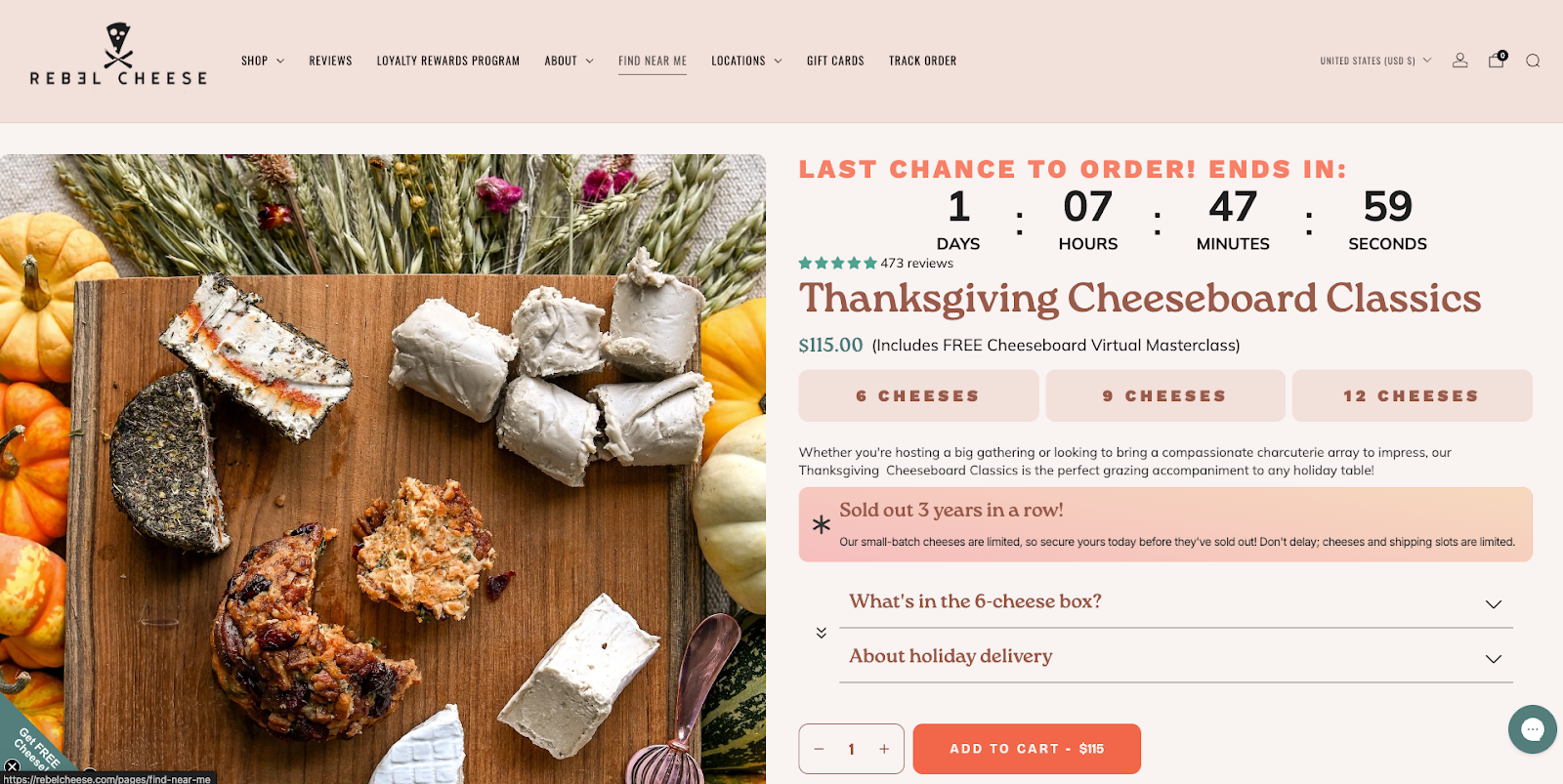
You could also set up presales, give people the option to add themselves to a waitlist, and provide early access to VIP shoppers.
5) Provide order cancellation and refund policies upfront
Give shoppers a heads up whether they’ll be able to cancel an order once placed, and what your refund policies are.
For example, cookware brand Misen follows its order confirmation email with a “change or cancel within one hour” email that provides a handy link to do so.
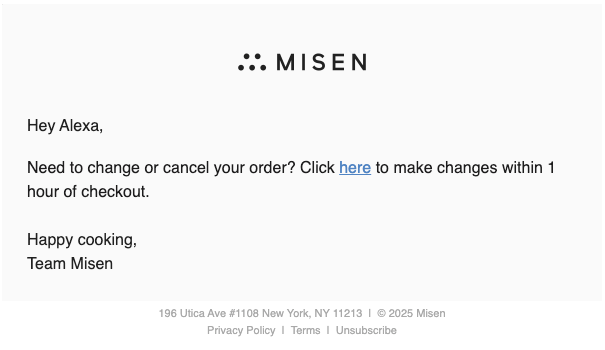
Your refund policies and order cancellations should live within an FAQ and in the footer of your website.
6) Add how-to information
Include how-to information on your website within your FAQs, on your blog, or as a standalone webpage. That might be sharing how to use a product, how to cook with it, or how to prepare it. This can prevent customers from asking questions like, “how do you use this?” or “how do I cook this?” or “what can I use this with?” etc.
For example, Purity Coffee created a full brewing guide with illustrations:
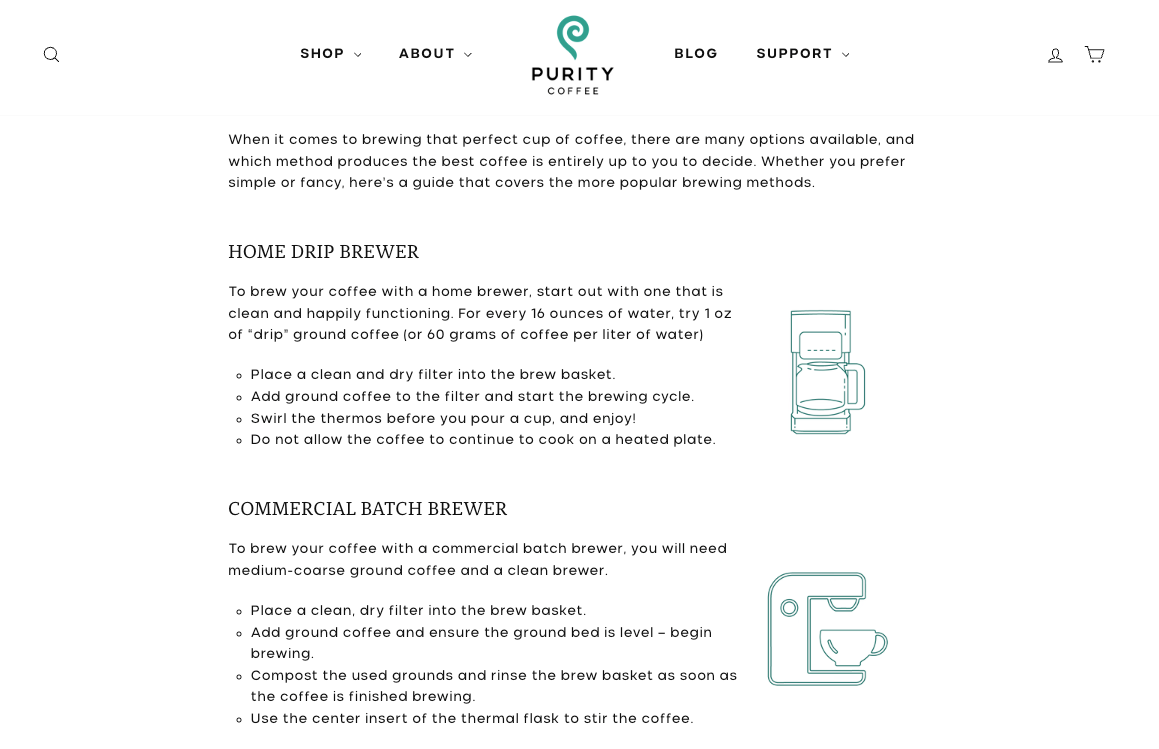
Similarly, for its unique preseasoned carbon steel pan, Misen lists out care instructions:

And for those who want to understand the level of prep and cooking time involved, The Dinner Ladies feature cooking instructions on each product page.
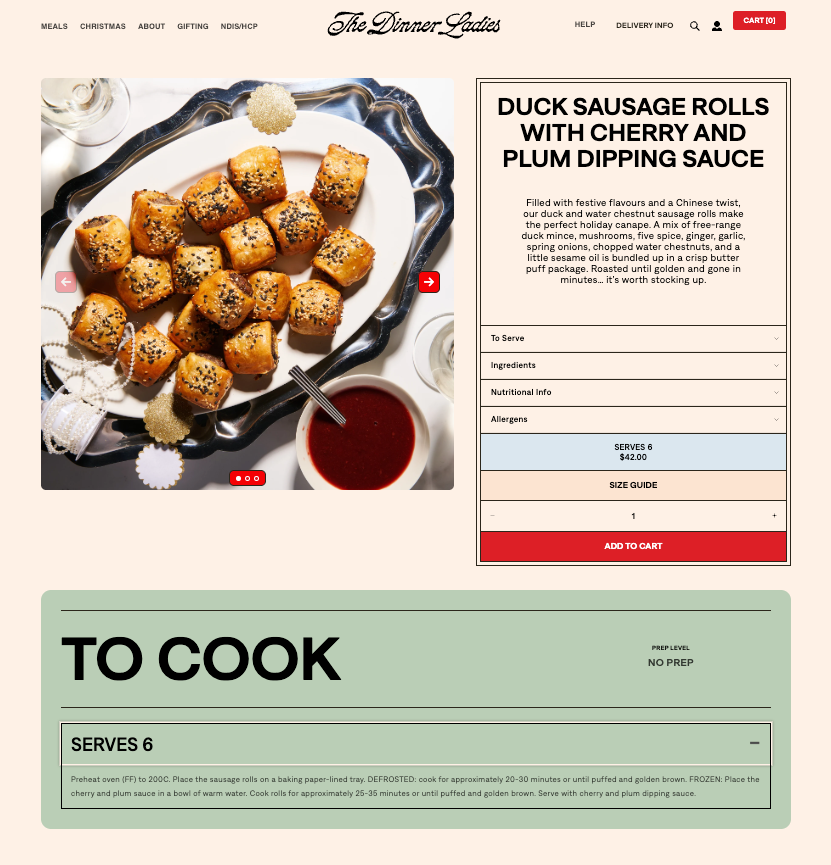
7) Build resources to help with buying decisions
Interactive quizzes, buying guides, and gift guides can help ensure shoppers choose the right items for them––without contacting you first.
For example, Trade Coffee Co created a quiz to help first timers find their perfect coffee match:
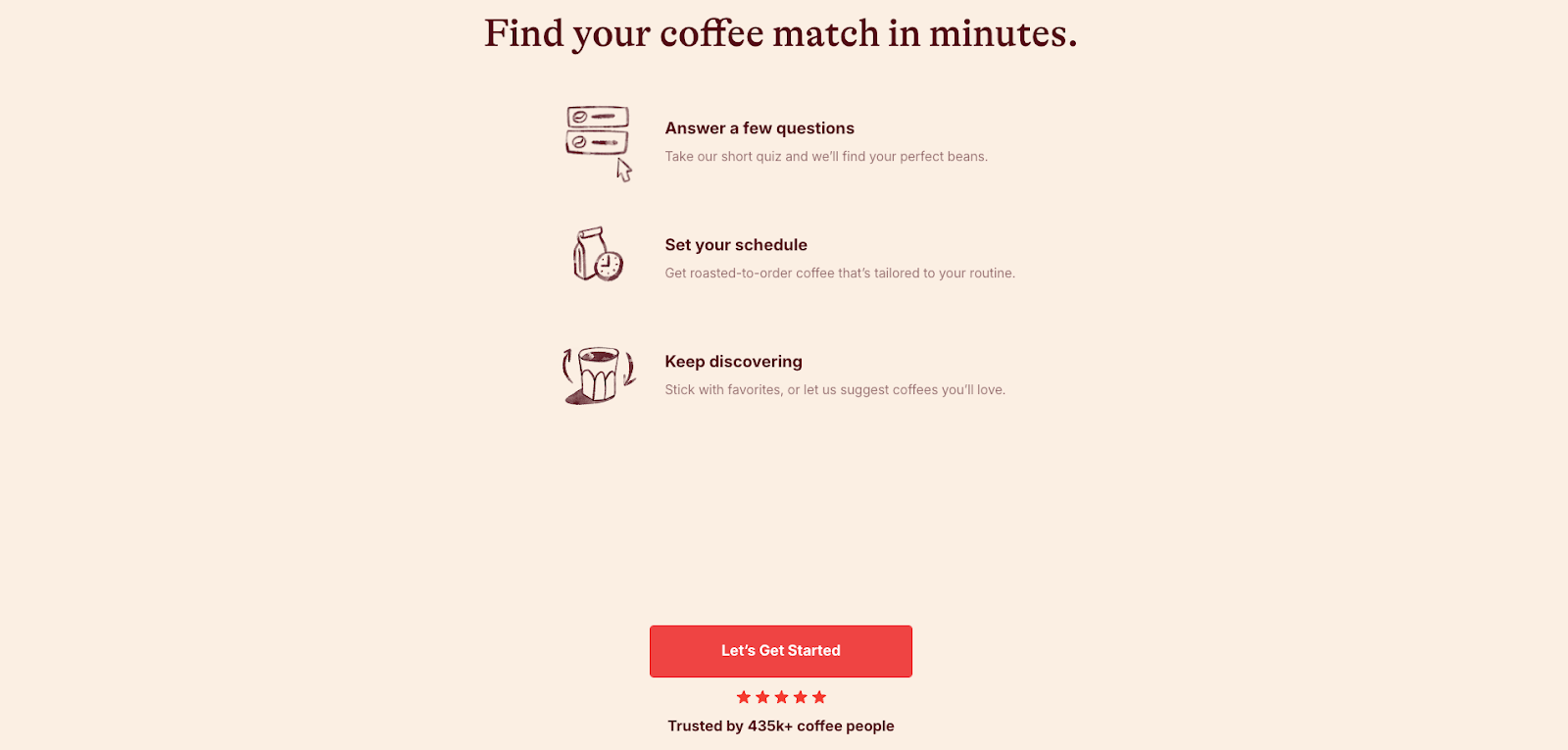
Set your team up for BFCM success with Gorgias
The more information you can share with customers upfront, the better. That will leave your team time to tackle the heady stuff.
If you’re looking for an AI-assist this season, check out Gorgias’s suite of products like AI Agent and Shopping Assistant.
{{lead-magnet-2}}
When Rhoback introduced an AI Agent to its customer experience team, it did more than automate routine tickets. Implementation revealed an opportunity to improve documentation, collaborate cross-functionally, and establish a clear brand tone of voice.
Samantha Gagliardi, Associate Director of Customer Experience at Rhoback, explains the entire process in the first episode of our AI in CX webinar series.
Key takeaways:
- Implement quickly and iterate. Rhoback’s initial rollout process took two weeks, right before BFCM. Samantha moved quickly, starting with basic FAQs and then continuously optimizing.
- Train AI like a three-year-old. Although it is empathetic, an AI Agent does not inherently know what is right or wrong. Invest in writing clear Guidance, testing responses, and ensuring document accuracy.
- Approach your AI’s tone of voice like a character study. Your AI Agent is an extension of your brand, and its personality should reflect that. Rhoback conducted a complete analysis of its agent’s tone, age, energy, and vocabulary.
- Embrace AI as a tool to reveal inconsistencies. If your AI Agent is giving inaccurate information, it’s exposing gaps in your knowledge sources. Uses these early test responses to audit product pages, help center content, Guidance, and policies.
- Check in regularly and keep humans in control. Introduce weekly reviews or QA rituals to refine AI’s accuracy, tone, and efficiency. Communicate AI insights cross-functionally to build trust and work towards shared goals.
Top learnings from Rhoback’s AI rollout
1. You can start before you “feel ready”
With any new tool, the pre-implementation phase can take some time. Creating proper documentation, training internal teams, and integrating with your tech stack are all important steps that happen before you go live.
But sometimes it’s okay just to launch a tool and optimize as you go.
Rhoback launched its AI agent two weeks before BFCM to automate routine tickets during the busy season.
Why it worked:
- Samantha had audited all of Rhoback’s SOPs, training materials, and FAQs a few months before implementation.
- They started by automating high-volume questions such as returns, exchanges, and order tracking.
- They followed a structured AI implementation checklist.
2. Audit your knowledge sources before you automate
Before turning on Rhoback’s AI Agent, Samantha’s team reviewed every FAQ, policy, and help article that human agents are trained on. This helped establish clear CX expectations that they could program into an AI Agent.
Samantha also reviewed the most frequently asked questions and the ideal responses to each. Which ones needed an empathetic human touch and which ones required fast, accurate information?
“AI tells you immediately when your data isn’t clean. If a product detail page says one thing and the help center says another, it shows up right away.”
Rhoback’s pre-implementation audit checklist:
- Review customer FAQs and the appropriate responses for each.
- Update outdated PDPs, Help Centre articles, policies, and other relevant documentation.
- Establish workflows with Ecommerce and Product teams to align Macros, Guidance, and Help Center articles with product descriptions and website copy.
Read more: How to Optimize Your Help Center for AI Agent
3. Train your AI Agent in small, clear steps
It’s often said that you should train your AI Agent like a brand-new employee.
Samantha took it one step further and recommended treating AI like a toddler, with clear, patient, repetitive instructions.
“The AI does not have a sense of good and bad. It’s going to say whatever you train it, so you need to break it down like you’re talking to a three-year-old that doesn’t know any different. Your directions should be so detailed that there is no room for error.”
Practical tips:
- Use AI to build your AI Guidance, focusing on clear, detailed, simple instructions.
- Test each Guidance before adding new ones.
- Treat the training process like an ongoing feedback loop, not a one-time upload.
Read more: How to Write Guidance with the “When, If, Then” Framework
4. Prioritize Tone of Voice to make AI feel natural
For Rhoback, an on-brand Tone of Voice was a non-negotiable. Samantha built a character study that shaped Rhoback’s AI Agent’s custom brand voice.
“I built out the character of Rhoback, how it talks, what age it feels like, what its personality is. If it does not sound like us, it is not worth implementing.”
Key questions to shape your AI Agent’s tone of voice:
- How does the AI Agent speak? Friendly, funny, empathetic, etc…?
- Does your AI Agent use emojis? How often?
- Are there any terms or phrases the AI Agent should always or never say?
5. Use AI to surface knowledge gaps or inconsistencies
Once Samantha started testing the AI Agent, it quickly revealed misalignment between Rhoback’s teams. With such an extensive product catalog, AI showed that product details did not always match the Help Center or CX documentation.
This made a case for stronger collaboration amongst the CX, Product, and Ecommerce teams to work towards their shared goal of prioritizing the customer.
“It opened up conversations we were not having before. We all want the customer to be happy, from the moment they click on an ad to the moment they purchase to the moment they receive their order. AI Agent allowed us to see the areas we need to improve upon.”
Tips to improve internal alignment:
- Create regular syncs between CX, Product, Ecommerce, and Marketing teams.
- Share AI summaries, QA insights, and trends to highlight recurring customer pain points.
- Build a collaborative workflow for updating documents that gives each team visibility.
6. Build trust (with your team and customers) through transparency
Despite the benefits of AI for CX, there’s still trepidation. Agents are concerned that AI would replace them, while customers worry they won’t be able to reach a human. Both are valid concerns, but clearly communicating internally and externally can mitigate skepticism.
At Rhoback, Samantha built internal trust by looping in key stakeholders throughout the testing process. “I showed my team that it is not replacing them. It’s meant to be a support that helps them be even more successful with what they’re already doing," Samantha explains.
On the customer side, Samantha trained their AI Agent to tell customers in the first message that it is an AI customer service assistant that will try to help them or pass them along to a human if it can’t.
How Rhoback built AI confidence:
- Positioned AI as a personal assistant for agents, not a replacement.
- Let agents, other departments, and leadership test and shape the AI Agent experience early.
- Told customers up front when automation was being used and made the path to a human clear and easy.
Read more: How CX Leaders are Actually Using AI: 6 Must-Know Lessons
Putting these into practice: Rhoback’s framework for an aligned AI implementation
Here is Rhoback’s approach distilled into a simple framework you can apply.
- Audit your content: Ensure your FAQs, product data, policies, and all documentation are accurate.
- Start small: Automate one repetitive workflow, such as returns or tracking.
- Train iteratively: Add Guidance in small, testable batches.
- Prioritize tone: Make sure every AI reply sounds like your brand.
- Align teams: Use AI data to resolve cross-departmental inconsistencies and establish clearer communication lines.
- Be transparent: Tell both agents and customers how AI fits into the process.
- Refine regularly: Review, measure, and adjust on an ongoing basis.
Watch the full conversation with Samantha to learn how AI can act as a catalyst for better internal alignment.
📌 Join us for episode 2 of AI in CX: Building a Conversational Commerce Strategy that Converts with Cornbread Hemp on December 16.
{{lead-magnet-1}}
TL;DR:
- You don’t need to rebuild your Help Center to make it work with AI—you just need to structure it smarter.
- AI Agent reads your content in three layers: Help Center, Guidance, and Actions, following an “if / when / then” logic to find and share accurate answers.
- Most AI escalations happen because Help Docs are vague or incomplete. Start by improving your top 10 ticket topics—like order status, returns, and refunds.
- Make your articles scannable, define clear conditions, link next steps, and keep your tone consistent. These small tweaks help AI Agent resolve more tickets on its own—and free up your team to focus on what matters most.
As holiday season support volumes spike and teams lean on AI to keep up, one frustration keeps surfacing, our Help Center has the answers—so why can’t AI find them?
The truth is, AI can’t help customers if it can’t understand your Help Center. Most large language models (LLMs), including Gorgias AI Agent, don’t ignore your existing docs, they just struggle to find clear, structured answers inside them.
The good news is you don’t need to rebuild your Help Center or overhaul your content. You simply need to format it in a way that’s easy for both people and AI to read.
We’ll break down how AI Agent reads your Help Center, finds answers, and why small formatting changes can help it respond faster and more accurately, so your team spends less time on escalations.
{{lead-magnet-1}}
How AI Agent uses your Help Center content
Before you start rewriting your Help Center, it helps to understand how AI Agent actually reads and uses it.
Think of it like a three-step process that mirrors how a trained support rep thinks through a ticket.
1. Read Help Center docs
Your Help Center is AI Agent’s brain. AI Agent uses your Help Center to pull facts, policies, and instructions it needs to respond to customers accurately. If your articles are clearly structured and easy to scan, AI Agent can find what it needs fast. If not, it hesitates or escalates.
2. Follow Guidance instructions
Think of Guidance as AI Agent’s decision layer. What should AI Agent do when someone asks for a refund? What about when they ask for a discount? Guidance helps AI Agent provide accurate answers or hand over to a human by following an “if/when/then” framework.
3. Respond and perform
Finally, AI Agent uses a combination of your help docs and Guidance to respond to customers, and if enabled, perform an Action on their behalf—whether that’s changing a shipping address or canceling an order altogether.
Here’s what that looks like in practice:
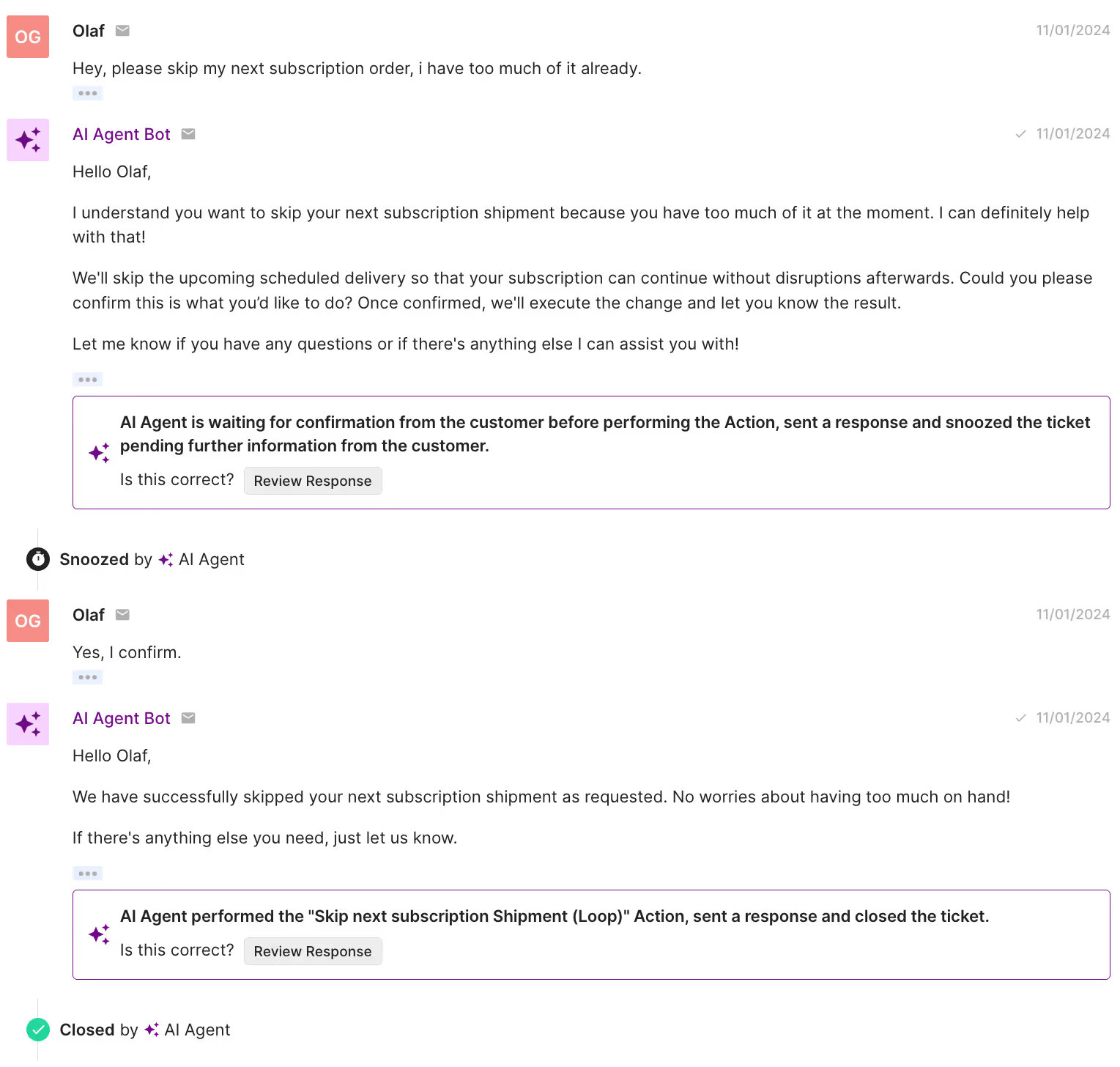
This structure removes guesswork for both your AI and your customers. The clearer your docs are about when something applies and what happens next, the more accurate and human your automated responses will feel.
A Help Center written for both people and AI Agent:
- Saves your team time
- Reduces escalations
- Helps every customer get the right answer the first time
What causes AI Agent to escalate tickets, and how to fix it
Our data shows that most AI escalations happen for a simple reason––your Help Center doesn’t clearly answer the question your customer is asking.
That’s not a failure of AI. It’s a content issue. When articles are vague, outdated, or missing key details, AI Agent can’t confidently respond, so it passes the ticket to a human.
Here are the top 10 topics that trigger escalations most often:
Rank |
Ticket Topic |
% of Escalations |
|---|---|---|
1 |
Order status |
12.4% |
2 |
Return request |
7.9% |
3 |
Order cancellation |
6.1% |
4 |
Product - quality issues |
5.9% |
5 |
Missing item |
4.6% |
6 |
Subscription cancellation |
4.4% |
7 |
Order refund |
4.1% |
8 |
Product details |
3.5% |
9 |
Return status |
3.3% |
10 |
Order delivered but not received |
3.1% |
Each of these topics needs a dedicated, clearly structured Help Doc that uses keywords customers are likely to search and spells out specific conditions.
Here’s how to strengthen each one:
- Order status: Include expected delivery timelines, tracking link FAQs, and a clear section for “what to do if tracking isn’t updating.”
- Return request: Spell out eligibility requirements, time limits, and how to print or request a return label.
- Order cancellation: Define cut-off times for canceling and link to your “returns” doc for shipped orders.
- Product quality issues: Explain what qualifies as a defect, how to submit photos, and whether replacements or refunds apply.
- Missing item: Clarify how to report missing items and what verification steps your team takes before reshipping.
- Subscription cancellation: Add “if/then” logic for different cases: if paused vs. canceled, if prepaid vs. monthly.
- Order refund: Outline refund timelines, where customers can see status updates, and any exceptions (e.g., partial refunds).
- Product details: Cover sizing, materials, compatibility, or FAQs that drive most product-related questions.
- Return status: State how long returns take to process and where to check progress once a label is scanned.
- Order delivered but not received: Provide step-by-step guidance for checking with neighbors, filing claims, or requesting replacements.
Start by improving these 10 articles first. Together, they account for nearly half of all AI Agent escalations. The clearer your Help Center is on these topics, the fewer tickets your team will ever see, and the faster your AI will resolve the rest.
How to format your Help Center docs for LLMs
Once you know how AI Agent reads your content, the next step is formatting your help docs so it can easily understand and use them.
The goal isn’t to rewrite everything, it’s to make your articles more structured, scannable, and logic-friendly.
Here’s how.
1. Use structured, scannable sections
Both humans and large language models read hierarchically. If your article runs together in one long block of text, key answers get buried.
Break articles into clear sections and subheadings (H2s, H3s) for each scenario or condition. Use short paragraphs, bullets, and numbered lists to keep things readable.
Example:
How to Track Your Order
- Step 1: Find your tracking number in your confirmation email.
- Step 2: Click the tracking link to see your delivery status.
- Step 3: If tracking hasn’t updated in 3 days, contact support.
A structured layout helps both AI and shoppers find the right step faster, without confusion or escalation.
2. Write for “if/when/then” logic
AI Agent learns best when your Help Docs clearly define what happens under specific conditions. Think of it like writing directions for a flowchart.
Example:
- “If your order hasn’t arrived within 10 days, contact support for a replacement.”
- “If your order has shipped, you can find the tracking link in your order confirmation email.”
This logic helps AI know what to do and how to explain the answer clearly to the customer.
3. Clarify similar terms and synonyms
Customers don’t always use the same words you do, and neither do LLMs. If your docs treat “cancel,” “stop,” and “pause” as interchangeable, AI Agent might return the wrong answer.
Define each term clearly in your Help Center and add small keyword variations (“cancel subscription,” “end plan,” “pause delivery”) so the AI can recognize related requests.
4. Link to next steps
AI Agent follows links just like a human agent. If your doc ends abruptly, it can’t guide the customer any further.
Always finish articles with an explicit next step, like linking to:
- A form
- Another article
- A support action page
Example: “If your return meets our policy, request your return label here.”
That extra step keeps the conversation moving and prevents unnecessary escalations.
5. Keep tone consistent
AI tools prioritize structure and wording when learning from your Help Center—not emotional tone.
Phrases like “Don’t worry!” or “We’ve got you!” add noise without clarity.
Instead, use simple, action-driven sentences that tell the customer exactly what to do:
- “Click here to request a refund.”
- “Fill out the warranty form to get a replacement.”
A consistent tone keeps your Help Center professional, helps AI deliver reliable responses, and creates a smoother experience for customers.
LLM-friendly Help Centers in action
You don’t need hundreds of articles or complex workflows to make your Help Center AI-ready. But you do need clarity, structure, and consistency. These Gorgias customers show how it’s done.
Little Words Project: Simple formatting that boosts instant answers
Little Words Project keeps things refreshingly straightforward. Their Help Center uses short paragraphs, descriptive headers, and tightly scoped articles that focus on a single intent, like returns, shipping, or product care.
That makes it easy for AI Agent to scan the page, pull out the right facts, and return accurate answers on the first try.
Their tone stays friendly and on-brand, but the structure is what shines. Every article flows from question → answer → next step. It’s a minimalist approach, and it works. Both for customers and the AI reading alongside them.
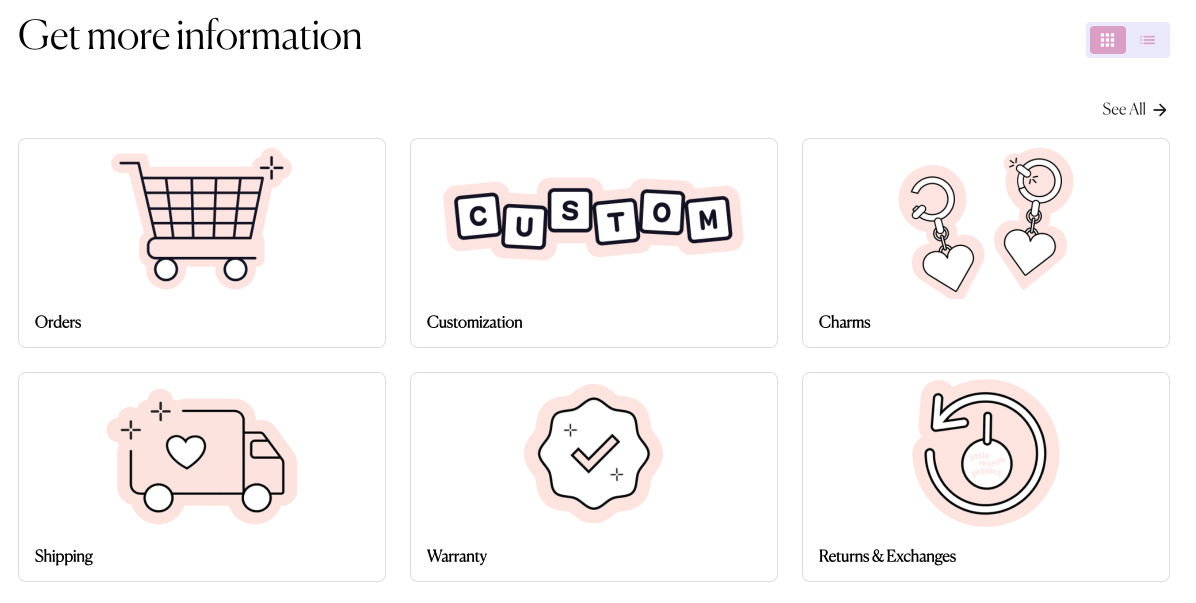
Dr. Bronner’s: Making tools work for the team
Customer education is at the heart of Dr. Bronner’s mission. Their customers often ask detailed questions about product ingredients, packaging, and certifications. With Gorgias, Emily and her team were able to build a robust Help Center that helped to proactively give this information.
The Help Center doesn't just provide information. The integration of interactive Flows, Order Management, and a Contact Form automation allowed Dr. Bronner’s to handle routine inquiries—such as order statuses—quickly and efficiently. These kinds of interactive elements are all possible out-of-the-box, no IT support needed.
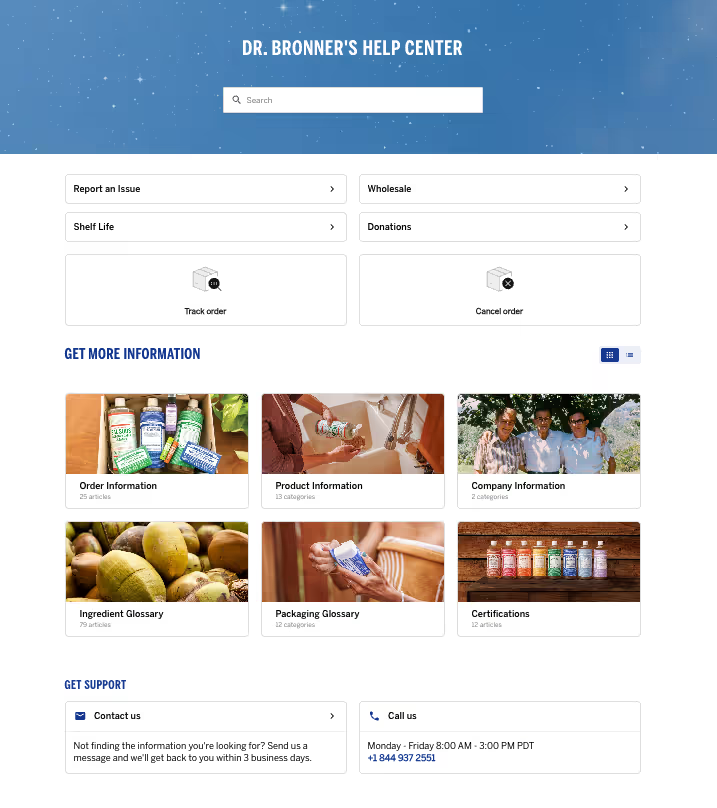
Ekster: Building efficiency through automation and clarity

When Ekster switched to Gorgias, the team wanted to make their Help Center work smarter. By writing clear, structured articles for common questions like order tracking, returns, and product details, they gave both customers and AI Agent the information needed to resolve issues instantly.
"Our previous Help Center solution was the worst. I hated it. Then I saw Gorgias’s Help Center features, and how the Article Recommendations could answer shoppers’ questions instantly, and I loved it. I thought: this is just what we need." —Shauna Cleary, Head of Ecommerce at Ekster
The results followed fast. With well-organized Help Center content and automation built around it, Ekster was able to scale support without expanding the team.
“With all the automations we’ve set up in Gorgias, and because our team in Buenos Aires has ramped up, we didn’t have to rehire any extra agents.” —Shauna Cleary, Head of Ecommerce at Ekster
Learn more: How Ekster used automation to cover the workload of 4 agents
Rowan: Clean structure that keeps customers (and AI) on track
Rowan’s Help Center is a great example of how clear structure can do the heavy lifting. Their FAQs are grouped into simple categories like piercing, shipping, returns, and aftercare, so readers and AI Agent can jump straight to the right topic without digging.
For LLMs, that kind of consistency reduces guesswork. For customers, it creates a smooth, reassuring self-service experience.
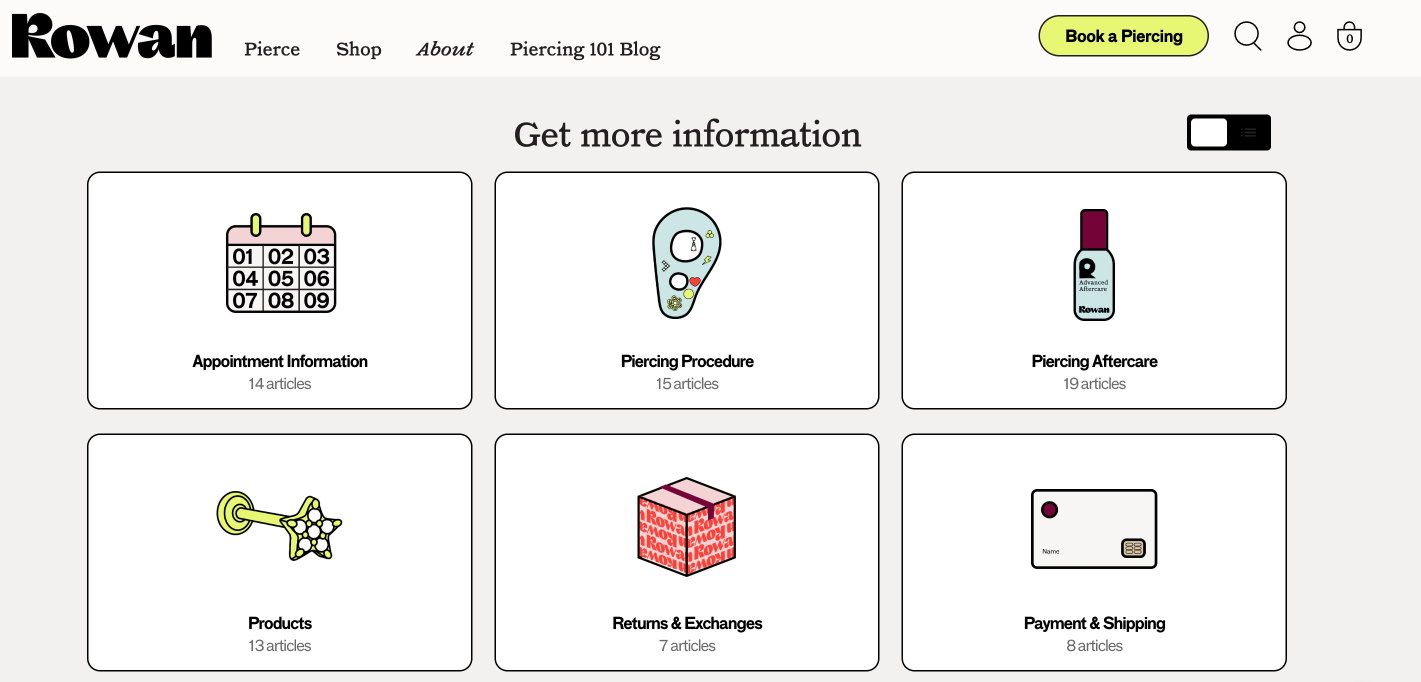
TUSHY: Balancing brand voice with automation
TUSHY proves you can maintain personality and structure. Their Help Center articles use clear headings, direct language, and brand-consistent tone. It makes it easy for AI Agent to give accurate, on-brand responses.
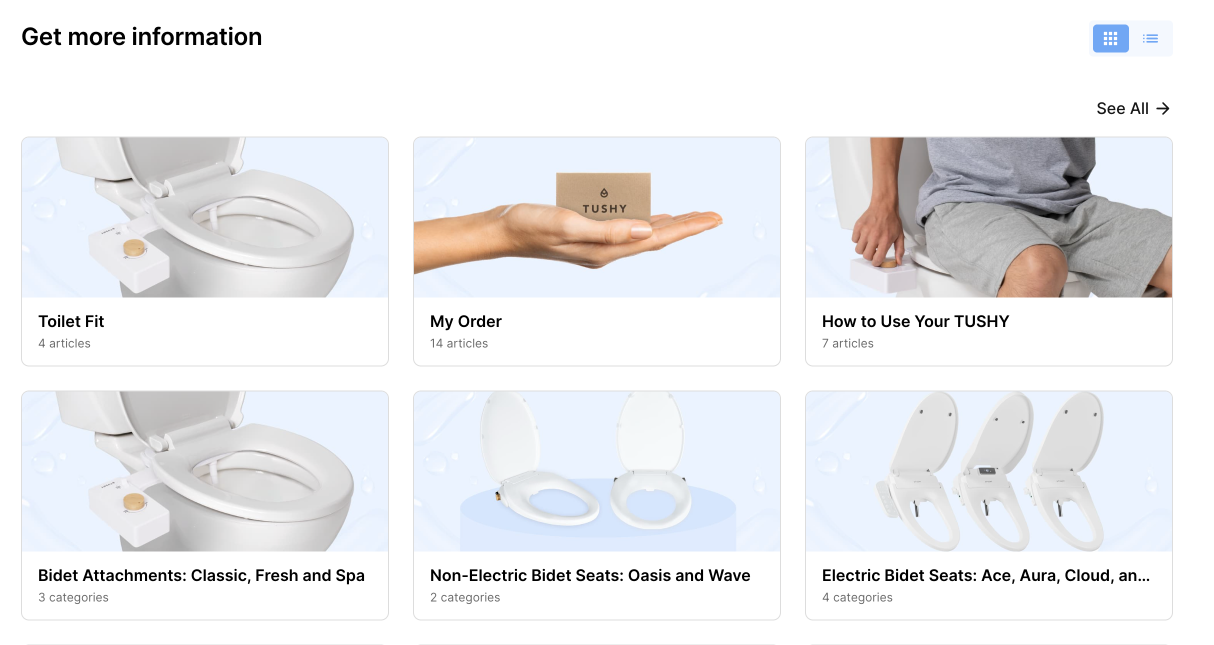
“Too often, a great interaction is diminished when a customer feels reduced to just another transaction. With AI, we let the tech handle the selling, unabashedly, if needed, so our future customers can ask anything, even the questions they might be too shy to bring up with a human. In the end, everybody wins!" —Ren Fuller-Wasserman, Senior Director of Customer Experience at TUSHY
Quick checklist to audit your Help Center for AI
Ready to put your Help Center to the test? Use this five-point checklist to make sure your content is easy for both customers and AI to navigate.
1. Are your articles scannable with clear headings?
Break up long text blocks and use descriptive headers (H2s, H3s) so readers and AI Agent can instantly find the right section.
2. Do you define conditions with “if/when/then” phrasing?
Spell out what happens in each scenario. This logic helps AI Agent decide the right next step without second-guessing.
3. Do you cover your top escalation topics?
Make sure your Help Center includes complete, structured articles for high-volume issues like order status, returns, and refunds.
4. Does each article end with a clear next step or link?
Close every piece with a call to action, like a form, related article, or support link, so neither AI nor customers hit a dead end.
5. Is your language simple, action-based, and consistent?
Use direct, predictable phrasing. Avoid filler like “Don’t worry!” and focus on steps customers can actually take.
By tweaking structure instead of your content, it’s easier to turn your Help Center into a self-service powerhouse for both customers and your AI Agent.
Make your Help Center work smarter
Your Help Center already holds the answers your customers need. Now it’s time to make sure AI can find them. A few small tweaks to structure and phrasing can turn your existing content into a powerful, AI-ready knowledge base.
If you’re not sure where to start, review your Help Center with your Gorgias rep or CX team. They can help you identify quick wins and show you how AI Agent pulls information from your articles.
Remember: AI Agent gets smarter with every structured doc you publish.
Ready to optimize your Help Center for faster, more accurate support? Book a demo today.
{{lead-magnet-2}}
Newsletter Signup
The best in CX and ecommerce, right to your inbox
Featured articles

How to Prep for Peak Season: BFCM Automation Checklist
TL;DR:
- Start by cleaning up your Help Center. Update your articles based on last year’s data, using plain language and clear policy details to boost self-service.
- Use automations to streamline ticket routing and support efficiency. Set rules for tagging, escalation, and inbox views, so your team can respond faster.
- Prep your macros, AI, and staffing plan in advance. Build responses for top FAQs, train AI on the right sources, and forecast agent needs to avoid burnout.
- Automate logistics, upselling, and QA to stay ahead. From showing shipping timelines to flagging low-quality responses, automation ensures smooth operations and more revenue during peak season.
Getting ready for that yearly ticket surge isn’t only about activating every automation feature on your helpdesk, it’s about increasing efficiency across your entire support operations.
This year, we’re giving you one less thing to worry about with our 2025 BFCM automation guide. Whether your team needs a tidier Help Center or better ticket routing rules, we’ve got a checklist for every area of the customer experience brought to you by top industry players, including ShipBob, Loop Returns, TalentPop, and more.
{{lead-magnet-1}}
2025 BFCM automation checklist
- Tidy up your Help Center
- Audit your docs
- Review last year’s BFCM data to find your must-have articles
- Update your policy details
- Edit content using easy-to-understand language
- Expedite your ticket routing automations
- Set up automated ticket tags
- Create an inbox view for each category
- Set escalation rules for urgent tickets
- Set up mandatory Ticket Fields
- Prep your macros and AI agent
- Write macros for your top FAQs
- Train your AI on the right sources
- Define the limits of what AI should handle
- Forecast your BFCM staffing needs
- Use ticket volume to estimate the number of agents
- Plan extra coverage with automation or outsourcing
- Run agent training sessions on BFCM protocols
- Map out your logistics processes
- Negotiate better rates and processing efficiencies
- Automate inventory reorder points
- Build contingency plans for disruptions
- Show shipping timelines on product pages
- Maximize profits with upselling automations
- Guide shoppers with smart recommendations
- Suggest alternatives when items are out of stock
- Engage hesitant shoppers with winback discounts
- Keep support quality high with QA automations
- Automate ticket reviews with AI-powered QA
- Track both agent and AI responses
- Turn QA insights into coaching opportunities
Tidy up your Help Center
Your customer knowledge base, FAQs, or Help Center is a valuable hub of answers for customers’ most asked questions. For those who prefer to self-serve, it’s one of the first resources they visit. To ensure customers get accurate answers, do the following:
- Audit your docs
- Review last year’s BFCM data to find your must-have articles
- Update your policy details
- Edit content using easy-to-understand language
1. Audit your docs
Take stock of what’s currently in your database. Are you still displaying low-engagement or unhelpful articles? Are articles about discontinued products still up? Start by removing outdated content first, and then decide which articles to keep from there.
Related: How to refresh your Help Center: A step-by-step guide
2. Review last year’s BFCM data to find your must-have articles
Are you missing key topics, or don’t have a database yet? Look at last year’s tickets. What were customers’ top concerns? Were customers always asking about returns? Was there an uptick in free shipping questions? If an inquiry repeats itself, it’s a sign to add it to your Help Center.
3. Update your policy details
An influx of customers means more people using your shipping, returns, exchanges, and discount policies. Make sure these have accurate information about eligibility, conditions, and grace periods, so your customers have one reliable source of truth.
Personalization tip: Loop Returns advises adjusting your return policy for different return reasons. With Loop’s Workflows, you can automatically determine which customers and which return reasons should get which return policies.
Read more: Store policies by industry, explained: What to include for every vertical
4. Edit content using easy-to-understand language
Customers want fast answers, so ensure your docs are easy to read and understand. Titles and answers should be clear. Avoid technical jargon and stick to simple sentences that express one idea. To accelerate the process, use AI tools like Grammarly and ChatGPT.
No time to set up a Help Center? Gorgias automatically generates Help Center articles for you based on what people are asking in your inbox.

Expedite your ticket routing automations
Think of ticket routing like running a city. Cars are your tickets (and customers), roads are your inboxes, and traffic lights are your automations and rules. The better you maintain these structures, the better they can run on their own without needing constant repairs from your CX team.
Here’s your ticket routing automation checklist:
- Tag every ticket
- Create views for each category you need (VIP, Returns, Troubleshooting, etc.)
- Set escalation rules for urgent tickets
- Set up mandatory Ticket Fields
1. Set up automated ticket tags
Instead of asking agents to tag every ticket, set rules that apply tags based on keywords, order details, or message type. A good starting point is to tag tickets by order status, returns, refunds, VIP customers, and urgent issues so your team can prioritize quickly.
Luckily, many helpdesks offer AI-powered tags or contact reasons to reduce manual work. For example, Gorgias automatically detects a ticket’s Contact Reason. The system learns from past interactions, tagging your tickets with more accuracy each time.

2. Create an inbox view for each category
Custom or filtered inbox views give your agents a filtered and focused workspace. Start with essential views like VIP customers, returns, and damages, then add specialized views that match how your team works.
If you’re using conversational AI to answer tickets, views become even more powerful. For example, you might track low CSAT tickets to catch where AI responses fall short or high handover rates to identify AI knowledge gaps. The goal is to reduce clutter so agents can focus on delivering support.
3. Set escalation rules for urgent tickets
Don’t get bogged down in minor issues while urgent tickets sit unanswered. Escalation rules make sure urgent cases are pushed to the top of your inbox, so they don’t risk revenue or lead to unhappy customers.
Tickets to escalate to agents or specialized queues:
- Lost packages
- Damaged items
- Defective items
- Failed payments
- Open tickets without a follow-up
4. Set up mandatory Ticket Fields to get data right off the bat
Ticket Fields add structure by requiring your team to capture key data before closing a ticket. For BFCM, make fields like Contact Reason, Resolution, and Return Reason mandatory so you always know why customers reached out and how the issue was resolved.
For CX leads, Ticket Fields removes guesswork. Instead of sifting through tickets one by one, you’ll have clean data to spot trends, report on sales drivers, and train your team.
Pro Tip: Use conditional fields to dig deeper without overwhelming agents. For example, if the contact reason is “Return,” automatically prompt the agent to log the return reason or product defect.
Prep your macros and AI agent
Macros and AI Agent are your frontline during BFCM. When prepped properly, they can clear hundreds of repetitive tickets. The key is to ensure that answers are accurate, up-to-date, and aligned with what you want AI to handle.
- Write macros for your most common FAQs
- Train your AI on the right sources
- Define the limits of what AI should handle
1. Write macros for your top FAQs
Customers will flood your inbox with the same questions: “Where’s my order?” “When will my discount apply?” “What’s your return policy?” Write macros that give short, direct answers up front, include links for details, and use placeholders for personalization.
Bad macro:
- “You can track your order with the tracking link. It should update soon.”
Good macro:
- “Hi {{customer_firstname}}, you can track your order here: {{tracking_link}}. Tracking updates may take up to 24 hours to appear. Here’s our shipping policy: [Help Center link].”
Pro Tip: Customers expect deep discounts this time of year. BPO agency C(x)atalyze recommends automating responses to these inquiries with Gorgias Rules. Include words such as “discount” AND “BFCM”, “holiday”, “Thanksgiving”, “Black Friday”, “Christmas”, etc.
2. Train your AI on the right sources
AI is only as good as the information you feed it. Before BFCM, make sure it’s pulling from:
- Your Help Center with updated FAQs and policies
- Internal docs on return windows, promos, and shipping cutoffs
- Product catalogs with the latest details and stock info
- BFCM-specific resources like discount terms or extended support hours
Double-check a few responses in Test Mode to confirm the AI is pulling the right information.

3. Define the limits of what AI should handle
Edge cases and urgent questions need a human touch, not an automated reply. Keep AI focused on quick requests like order status, shipping timelines, or promo eligibility. Complex issues, like defective products, VIP complaints, and returns, can directly go to your agents.
Pro Tip: In Gorgias AI Agent settings, you can customize how handovers happen on Chat during business hours and after hours.
Forecast your BFCM staffing needs
Too few agents and you prolong wait times and miss sales. Too many and you’ll leave your team burned out. Capacity planning helps you find the balance to handle the BFCM surge.
1. Use ticket volume to estimate the number of agents
Use your ticket-to-order ratio from last year as a baseline, then apply it to this year’s forecast. Compare that number against what your team can realistically handle per shift to see if your current staffing plan holds up.
Read more: How to forecast customer service hiring needs ahead of BFCM
2. Plan extra coverage with automation or outsourcing
You still have options if you don’t have enough agents helping you out. Customer service agency TalentPop recommends starting by identifying where coverage will fall short, whether that’s evenings, weekends, or specific channels. Then decide whether to increase automation and AI use or bring in temporary assistance.
3. Run agent training sessions on BFCM protocols
Before the holiday season, run refreshers on new products, promos, and policy changes so no one hesitates when the tickets roll in. Pair training with cheat sheets or an internal knowledge base, giving your team quick access to the answers they’ll need most often.
Map out your logistics processes
Expect late shipments, low inventory, and more returns than usual during peak season. With the proper logistics automations, you can stay ahead of these issues while reducing pressure on your team.
ShipBob and Loop recommend the following steps:
- Negotiate better rates and processing efficiencies
- Automate your reverse logistics
- Connect your store, 3PL, and WMS
- Automate inventory reorder points
- Show shipping timelines on product pages
1. Negotiate better rates and processing efficiencies
Shipping costs add up fast during peak season. Work with your 3PL or partners like Loop Returns to take advantage of negotiated carrier rates and rate shopping tools that automatically select the most cost-effective option for each order.
2. Automate inventory reorder points
To maintain a steady supply of products, set automatic reorder points at the SKU level so reorders are triggered once inventory dips below a threshold. More lead time means fewer ‘out of stock’ surprises for your customers.
3. Build contingency plans for disruptions
Bad weather, delays, or unexpected demand can disrupt shipping timelines. Create a playbook in advance so your team knows exactly how to respond when things go sideways. At minimum, your plan should cover:
- Weather disruptions - Do you have a backup plan if carriers can’t pick up shipments due to storms or severe conditions?
- Carrier overloads - Which alternative carriers or routes can you switch to if primary partners are at capacity?
- Inventory shortages - How will you handle overselling, low stock alerts, or warehouse imbalances?
- Demand drop-offs - How will you reallocate inventory if BFCM sales don’t match forecasts?
4. Show shipping timelines on product pages
Customers want to know when their order will arrive before they hit checkout. Add estimated delivery dates and 2-day shipping badges directly on product pages. These cues help shoppers make confident decisions and reduce pre-purchase questions about shipping times.
Pro Tip: To keep those timelines accurate, build carrier cutoff dates into your Black Friday logistics workflows with your 3PL or fulfillment team. This allows you to avoid promising delivery windows your carriers can’t meet during peak season.
Maximize profits with upselling automations
You’ve handled the basics, from ticket routing to staffing and logistics. Now it’s time to go beyond survival. Upselling automations create an end-to-end experience that enhances the customer journey, shows them products they’ll love, and makes it easy to buy more with confidence. To put them to work:
- Guide shoppers with smart recommendations
- Suggest alternatives when items are out of stock
- Engage hesitant shoppers with winback discounts
1. Guide shoppers with smart recommendations
BFCM puts pressure on customers to find the right deal fast, but many don’t know what they’re looking for. Make it easier for them with macros that point shoppers to bestsellers or curated bundles. For a more advanced option, conversational AI like Gorgias Shopping Assistant can guide browsers on their own, even when your agents are offline.
2. Suggest alternatives when items are out of stock
No need to damage your conversion rate just because customers missed the items they wanted. Automations can recommend similar or complementary products, keeping customers engaged rather than leaving them empty-handed.
If an item is sold out, set up automations to:
- Suggest similar items like another size, color, or variation of the same product.
- Highlight premium upgrades such as a newer model or higher-value version that’s in stock.
- Cross-sell and offer bundles to keep the order valuable even without the original item.
- Notify customers about restocks by letting shoppers sign up for back-in-stock alerts.
3. Engage hesitant customers with winback discounts
Automations can detect hesitation through signals like abandoned carts, long checkout times, or even customer messages that mention keywords such as “too expensive” or “I’ll think about it.” In these cases, trigger a small discount to encourage the purchase.
You can take this a step further with conversational AI like Gorgias Shopping Assistant, which detects intent in real time. If a shopper seems uncertain, it can proactively offer a discount code based on the level of their buying intent.
Keep support quality high with QA automations
During BFCM, speed alone is not enough. Customers expect accurate, helpful, and on-brand responses, even when volume is at its highest. QA automations help you prioritize quality by reviewing every interaction automatically and flagging where standards are slipping. To make QA part of your automation prep:
- Automate ticket reviews with AI-powered QA
- Track both agent and AI responses
- Turn QA insights into coaching opportunities
1. Automate ticket reviews with AI-powered QA
Manual QA can only spot-check a small sample of tickets, which means most interactions go unreviewed. AI QA reviews every ticket automatically and delivers feedback instantly. This ensures consistent quality, even when your team is flooded with requests.
Compared to manual QA, AI QA offers:
- Full coverage: Every ticket is reviewed, not just a sample.
- Instant feedback: Agents get insights right after closing tickets.
- Consistency: Reviews are unbiased and use the same criteria across all interactions.
- Scalability: Works at any ticket volume without slowing down your team.
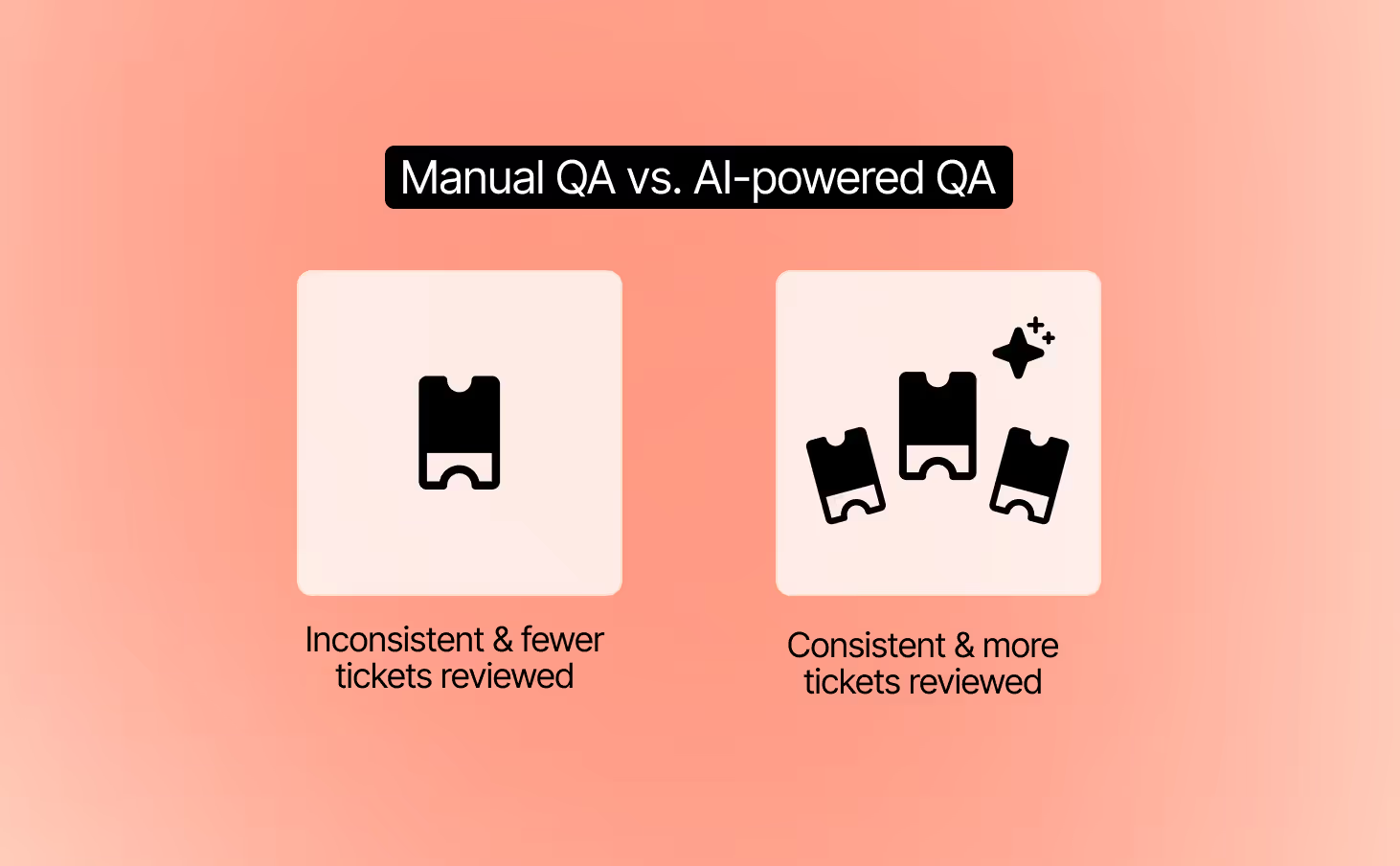
2. Track both agent and AI responses
Customers should get the same level of quality no matter who replies. AI QA evaluates both human and AI conversations using the same criteria. This creates a fair standard and gives you confidence that every interaction meets your brand’s bar for quality.
3. Turn QA insights into coaching opportunities
QA automation is not just about grading tickets. It highlights recurring issues, unclear workflows, or policy confusion. Use these insights to guide targeted coaching sessions and refine AI guidance so both humans and AI deliver better results.
Pro Tip: Pilot your AI QA tool with a small group of agents before peak season. This lets you validate feedback quality and scale with confidence when BFCM volume hits.
Give your ecommerce strategy a boost this holiday shopping season
The name of the game this Black Friday-Cyber Monday isn’t just to get a ton of online sales, it’s to set up your site for a successful holiday shopping season.
If you want to move the meter, focus on setting up strong BFCM automation flows now.
Gorgias is designed with ecommerce merchants in mind. Find out how Gorgias’s time-saving CX platform can help you create BFCM success. Book a demo today.
{{lead-magnet-2}}
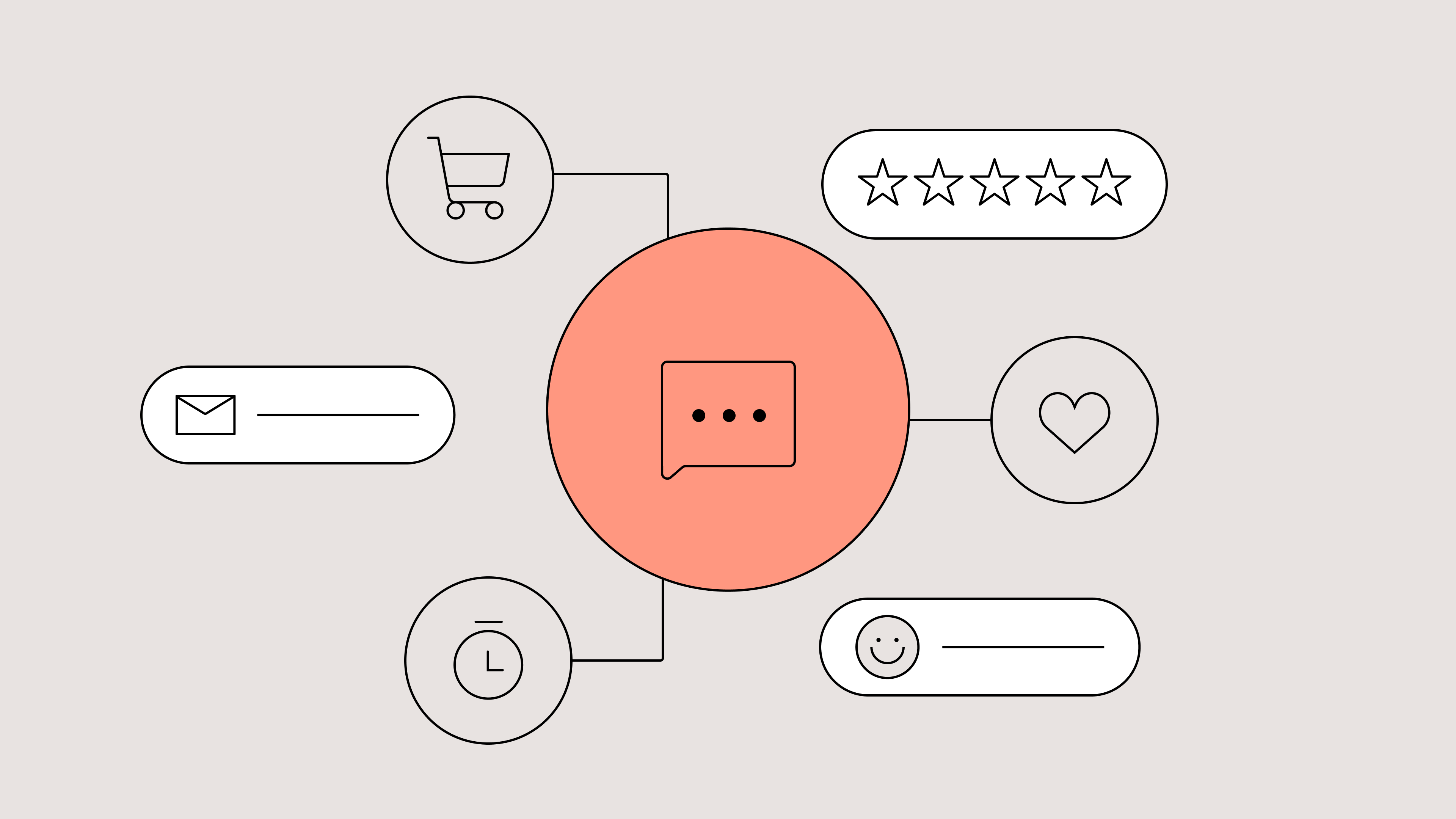
The Power of Suggestion: Why Subtle Cues Create Better Conversations
TL;DR:
- Suggestion turns browsing into buying by gently guiding action instead of forcing it.
- Fewer, clearer choices reduce decision fatigue and help shoppers move forward with confidence.
- A well-timed prompt with a friendly tone can make automation feel like a real conversation.
- Good design earns trust by being subtle, approachable, and easy to engage with.
- Small, thoughtful cues create moments of connection that make shoppers feel understood.
Shopping today isn’t a linear funnel. It’s a fluid conversation. Browse → question → help → buy → return → repeat.
Every step is a dialogue between the shopper’s intent and the brand’s response.
But what bridges the gap between “just looking” and “I’m buying” isn’t persuasion or urgency — it’s suggestion: the subtle design, timing, and language cues that guide action without forcing it.
When done well, suggestion becomes the architecture of trust. It’s also the best way to make AI-powered experiences feel human-first, not tech-first.
This article explores how the power of suggestion — rooted in behavioral psychology and UX design — shapes modern conversational commerce.
{{lead-magnet-1}}
Why suggestion matters in the age of conversational commerce
The average ecommerce shopper faces thousands of micro-decisions from the moment they land on a site. Which product? Which variant? Which review to trust? Which shipping method? Each one adds cognitive weight.
Psychologist Barry Schwartz coined the term The Paradox of Choice to describe how abundance often leads to paralysis. In his research, participants faced with too many options were less likely to make a choice and less satisfied when they did.
In ecommerce, that means overload costs conversions. When shoppers must evaluate too many variables, they hesitate, second-guess, or abandon.
Shoppers today expect empathy and ease, not persuasion. When you suggest rather than push, you signal empathy and support.
This is especially important for conversational commerce. Suggestion humanizes automation by making AI interactions feel like conversations rather than transactions.
When you push and persuade, you create a memorable experience for customers — but it’s not the kind you want them to remember.
One Reddit thread perfectly captures the problem: a user tried to cancel their Thrive Market membership and had to ask nine times before the chatbot complied.
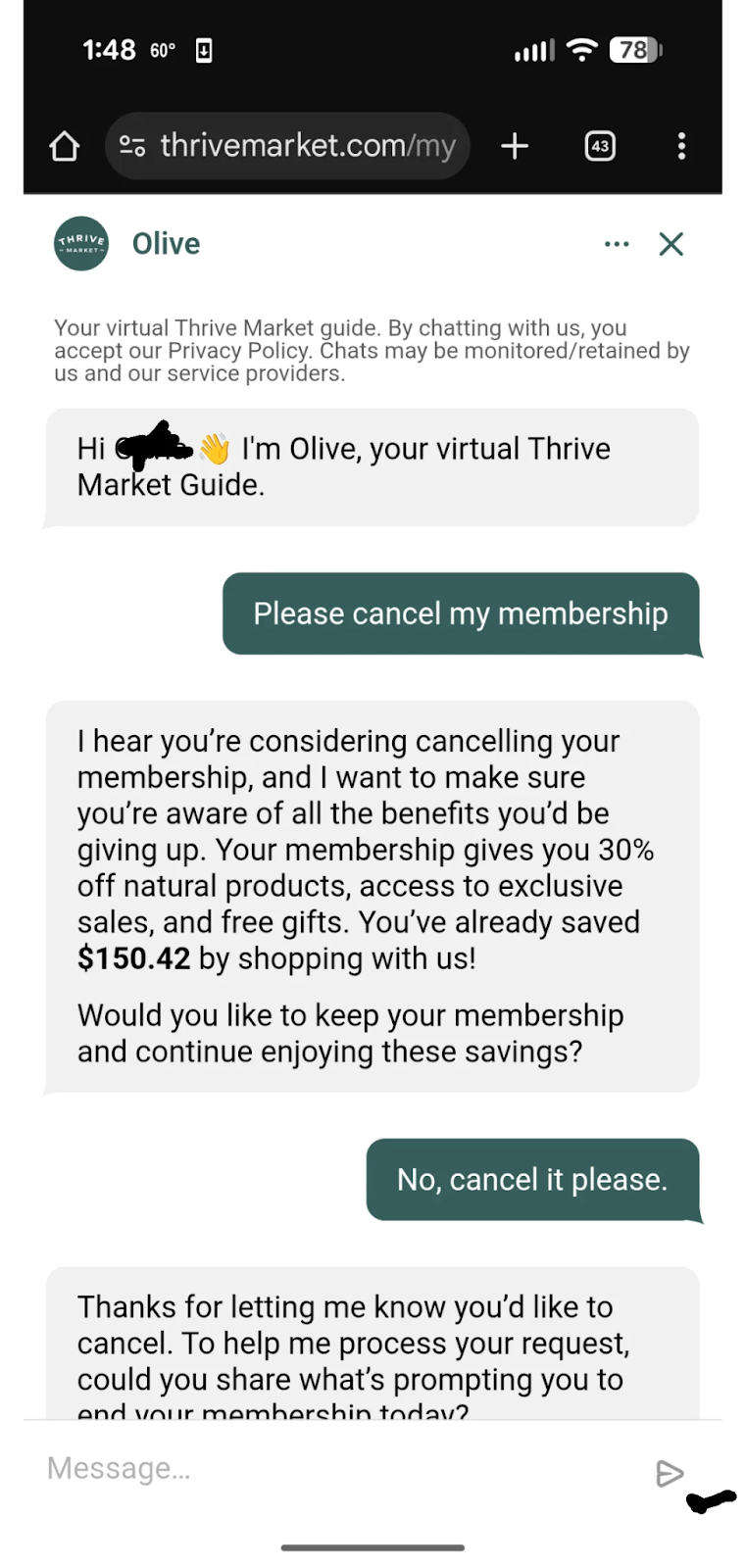
Each time, the AI assistant tried to talk them out of it (offering deals, guilt-tripping responses, or irrelevant messages) until the customer’s frustration boiled over.
The thread exploded not just because it was mildly infuriating, but because it illustrated what customers fear most about automation: a lack of empathy.
Suggestion is how you design for trust, ease, and interaction. And for ecommerce and CX professionals, suggestion bridges browsing and buying by prompting dialogue in a gentle, psychologically sound way.
5 ways to use suggestion with agentic AI
The magic of suggestion is that it works with human psychology, not against it. It bridges the space between what a shopper wants to do and what helps them do it.
That’s the foundation of the Fogg Behavior Model, developed by Stanford’s Dr. BJ Fogg. The model states that behavior happens when three things intersect:
- Motivation — the user wants to do something.
- Ability — they can do it easily.
- Prompt — they’re nudged at the right moment.
When these three align, the likelihood of action skyrockets.
In conversational commerce, suggestion is the gentle push that turns intent into interaction.
Below are five ways to apply suggestion with agentic AI (think chat, assistants, and marketing tools) to drive trust, dialogue, and conversion.
1. Build trust with a friendly invitation
A first impression shapes the entire interaction.
A greeting like “Need help?” or “Looking for something special?” signals availability without applying pressure. It’s the digital equivalent of a store associate smiling and saying, “Let me know if you need anything.”
This works because of linguistic framing, which is a form of persuasive language that subtly shapes how people interpret intent.
- Sentences using personal pronouns (“you,” “we”) increase perceived warmth and empathy.
- Questions (vs. imperatives) activate a conversational schema in the brain, inviting a cooperative response.
- Short, low-stakes phrasing signals that engagement is voluntary.
In practice, this means:
- Replace “Start chat now” with “Need a hand finding the right fit?”
- Use punctuation and tone cues that convey friendliness.
- Let the chat invite linger rather than pop up suddenly — this gives users agency.
Take a look at Glamnetic. Its shopping assistant sits at the bottom-right corner of every page. While shoppers scroll on the homepage, a prompt appears: “Shop with AI.” It’s transparent about being an AI chat, but subtle enough to be there for shoppers when they’re ready to use it at their own leisure.
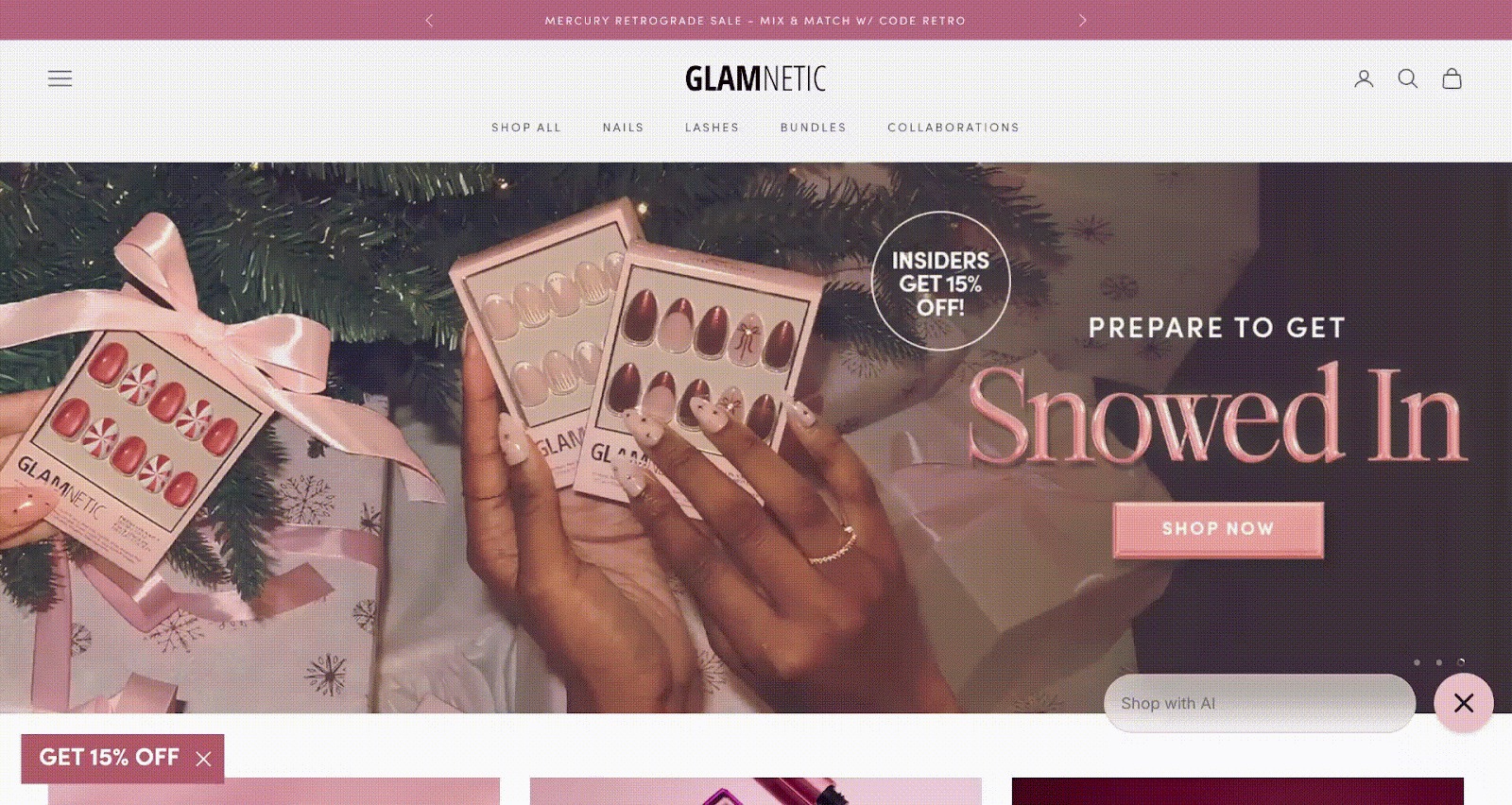
Gorgias Shopping Assistant is an easy way to do this. At the right moment, Shopping Assistant appears with a greeting such as “Need help?” or “Chat with our AI!” It’s friendly, low-pressure, optional, more “Hey I’m here if you need” than “Buy now!”
2. Make decisions easier by offering fewer choices
If you’ve ever scrolled through 80 product filters and given up, you’ve experienced choice overload. This is the Paradox of Choice in action:
More options = higher cognitive effort = lower satisfaction.
Suggestion works because it reduces mental effort. When an AI assistant limits quick-reply options to just a few (say, “Long sleeve,” “Short sleeve,” “Sleeveless”), it transforms chaos into clarity.
Each small tap provides forward momentum, a concept known as the goal-gradient effect: the closer we feel to completing a goal, the faster and more positively we act.
How can you apply this to agentic AI?
- Keep quick replies between 3–5 choices — enough to feel personalized, not overwhelming.
- Present them as progressive steps, not isolated decisions (e.g., “Show me styles” → “Show me colors” → “Add to cart”).
- Always include a “Something else” or “Other” option to preserve user autonomy.
- Refresh options dynamically based on prior selections — a technique known as choice scaffolding.
Gorgias’s Shopping Assistant does this well, surfacing only the most relevant next steps. Instead of forcing open-ended typing, it guides shoppers through mini-decisions that build confidence. Here’s an example from Okanui, showing four clear options to reply to Shopping Assistant.
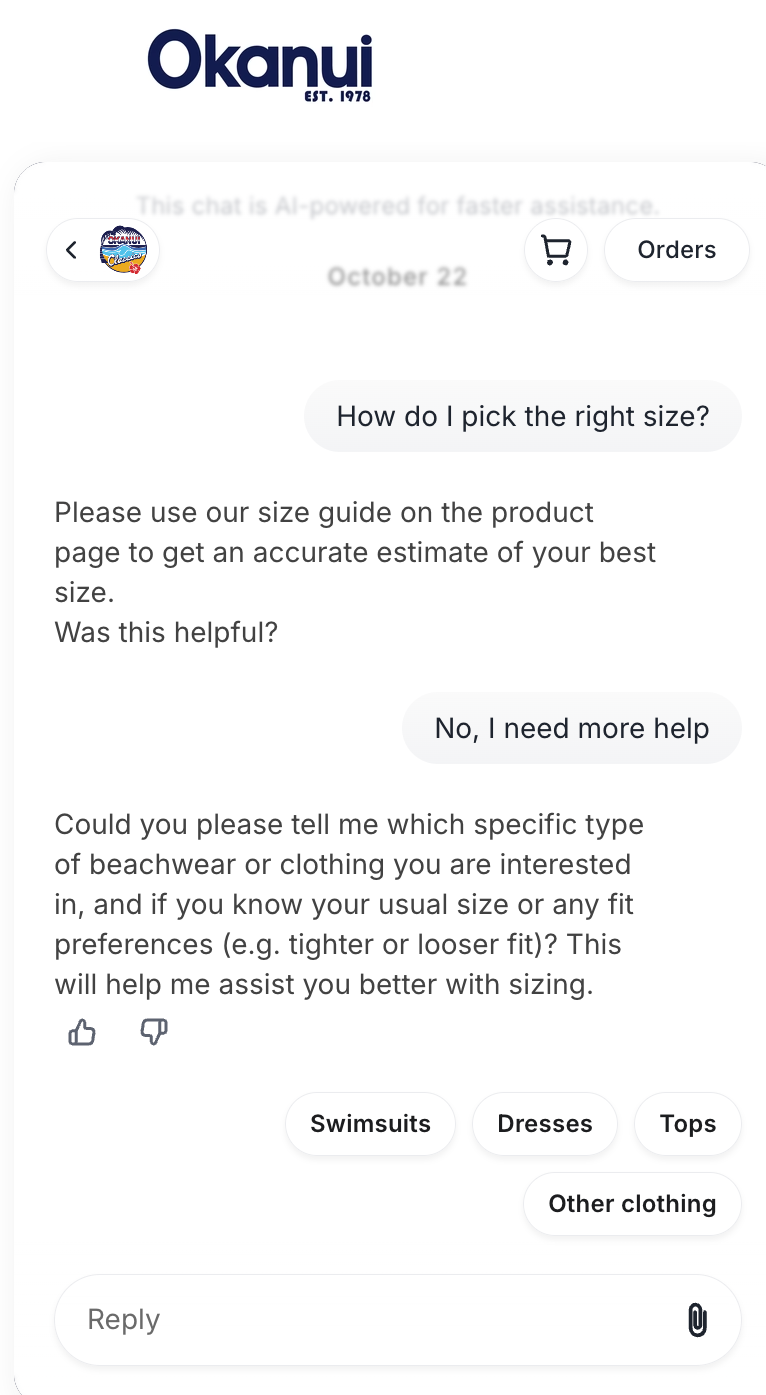
3. Encourage interaction with a user-friendly design
Before a shopper reads a single word of text, their brain has already judged whether your interface feels safe to engage with.
That’s the Aesthetic–Usability Effect — when people perceive something as visually appealing, they assume it will be easier and more trustworthy to use.
Design psychologist Don Norman put it best: “Attractive things work better because they make people feel better.”
Here’s why visual subtlety matters:
- Rounded edges and soft shapes signal continuity and friendliness (the human brain associates curves with safety; sharp angles with danger).
- Muted palettes and neutral contrast lower visual stress, allowing the interface to fade into the background until needed.
- Micro-animations — like a gentle glow or slide-in — trigger attention without hijacking focus.
- Minimizable elements give users a sense of control, reducing resistance to engagement.
OSEA’s product description page is a beautiful example of unintrusive design in action. The buttons have rounded edges, the 10% offer isn’t covering other page elements, and the chat sits in the bottom-right corner, making it easily accessible if a shopper has questions about the product.
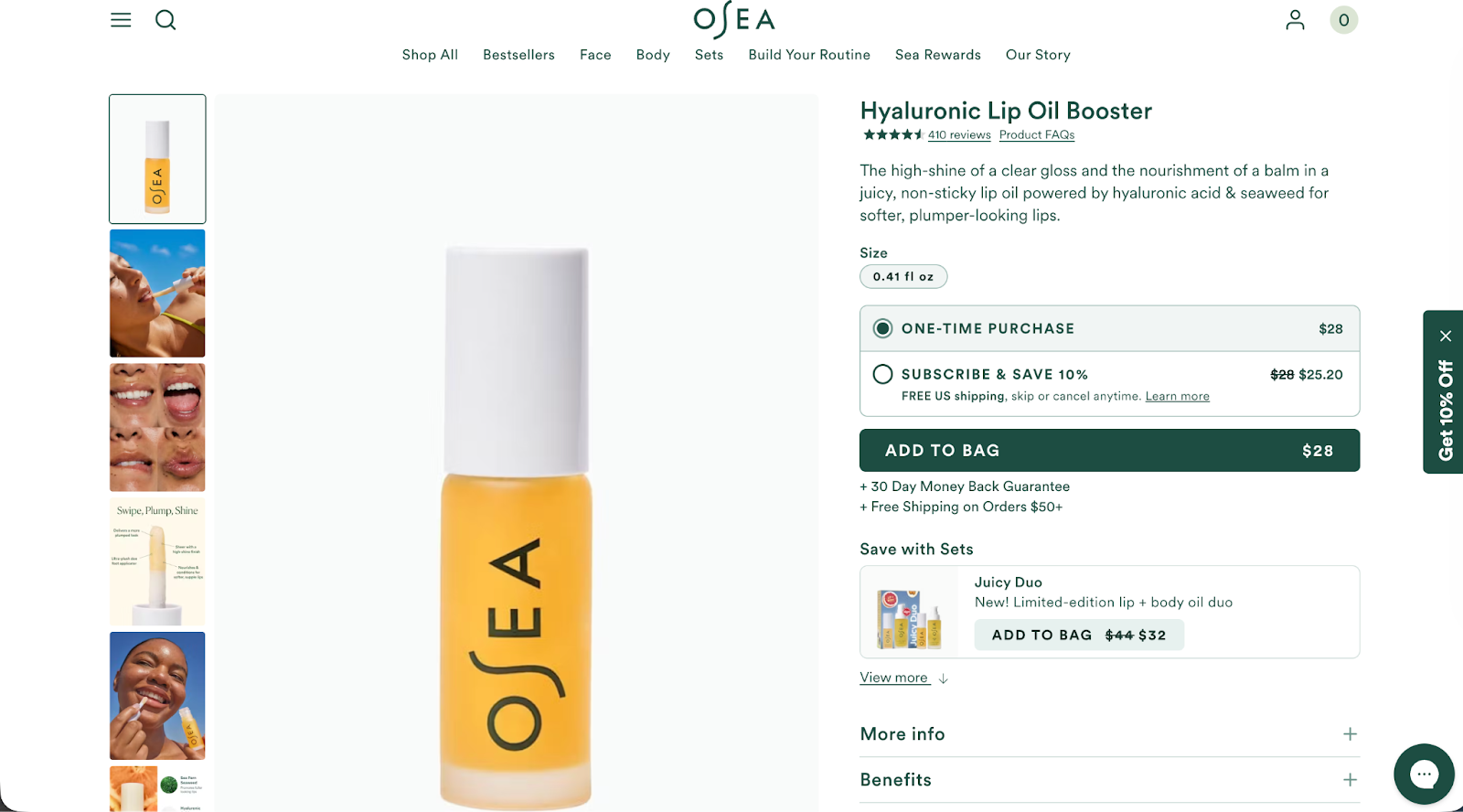
4. Match your timing to the customer’s pace
Timing is everything in suggestion-based design. Even the most thoughtful interaction will fail if it appears at the wrong moment.
That’s where the Fogg Behavior Model becomes tactical: Behavior = Motivation × Ability × Prompt
When shoppers are motivated (interested in a product) and able (engaging is easy), a well-timed prompt (chat bubble, message, or offer) turns potential into action.
But mistime it, and you risk the opposite. A chat that appears too early feels like spam. Too late, and the user’s interest window closes.
Here’s how to align the timing sweet spot:
- Use behavioral triggers: Fire prompts after meaningful engagement (e.g., 25–30 seconds on a product page, reaching 70% scroll depth, or idling for 15 seconds).
- Match prompt to context: Offer size guidance on apparel pages, warranty info near checkout, or live help on return pages.
- Respect frequency: One well-placed nudge beats five redundant ones.
- Localize timing: Adjust based on device and location. Mobile users often need faster cues due to shorter browsing sessions.
Gorgias Shopping Assistant does all of the above. Using context — such as the current page, conversational context, and cart behavior — helps the AI trigger prompts like “Need help choosing a size?” or “Have questions about shipping?”
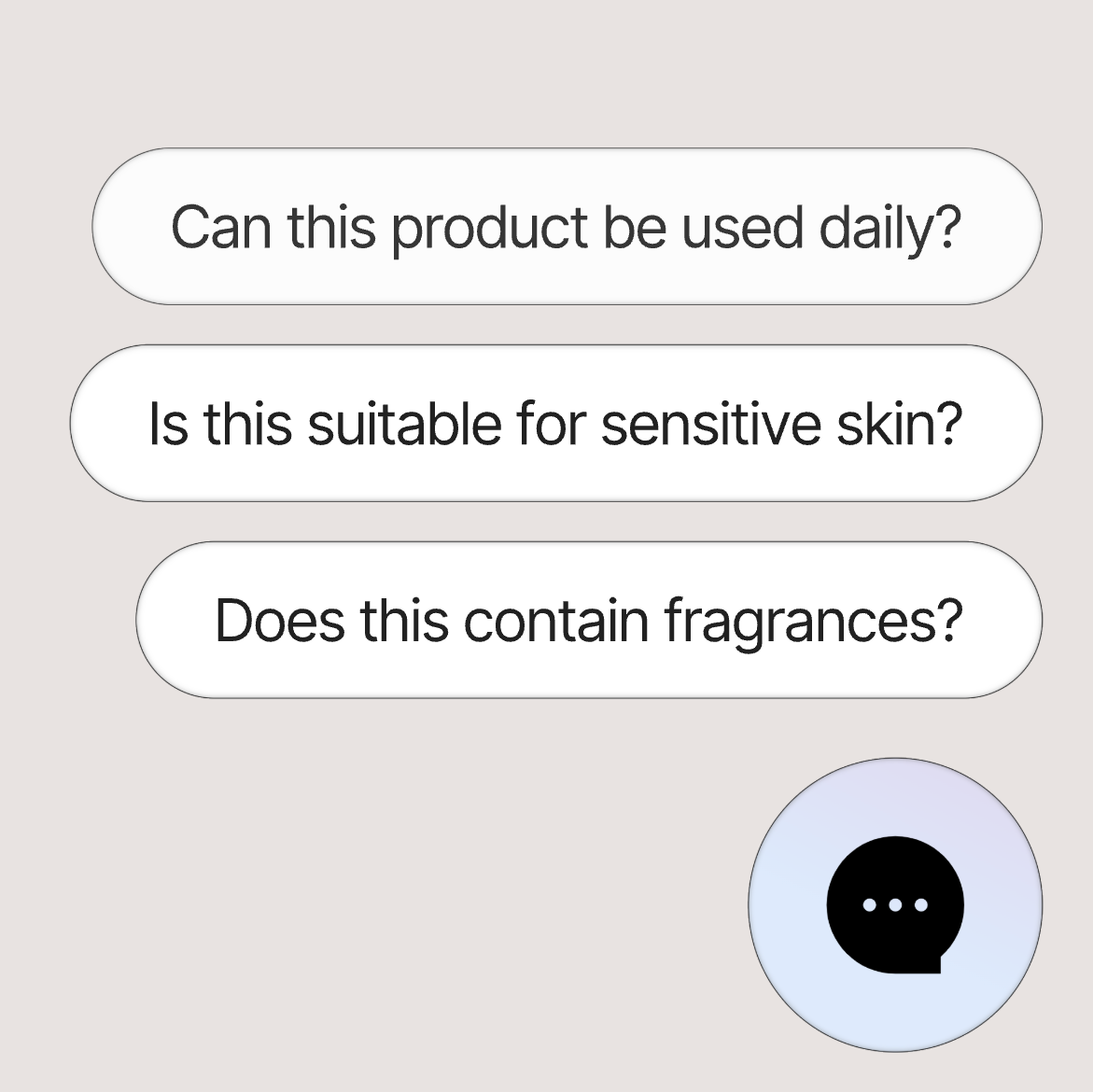
5. Aim to educate, reassure, or inspire — not just sell
Every small suggestion — a phrase, a button shape, a pause, a tone — creates what behavioral economists call a moment of micro-trust.
Individually, these moments may feel insignificant. But together, they turn a static interface into a relationship.
When greeting, choices, design, and timing align, conversation becomes the natural outcome — not the goal. That’s what conversational commerce gets right: it reframes success from “did they convert?” to “did they connect?”
For CX teams, this shift requires designing for the emotional continuity of the experience:
- Did each prompt respect the shopper’s autonomy?
- Did the interaction feel like a two-way exchange?
- Did the system adapt to intent rather than dictate it?
We love this example from Perry Ellis to drive this tip home:

Designing for trust in an age of AI
As AI continues to shape how people shop, brands face a choice: Design for control, or design for trust.
Suggestion is the path to the latter.
The right cue, delivered at the right time, reminds people that even in automated spaces, there’s still room for empathy and understanding.
Gorgias was built on the belief that great commerce starts with conversation, not conversion.
{{lead-magnet-2}}

AI Agent Keeps Getting Smarter (Here’s the Data to Prove It)
TL;DR:
- AI Agent is getting more accurate every month: It’s improved 14.9% this year thanks to better LLMs, constant updates, and user feedback.
- It writes more correctly than most humans: With a 4.77/5 language score, it’s nailing grammar, tone, and clarity better than human agents.
- It’s empathetic, too: AI Agent now shows more empathy and listens better than human agents.
- Brands are gaining confidence fast: Quality scores jumped from 57% to 85% in just a few months, and CX teams are noticing.
- Customers are almost as happy with AI as with humans: AI Agent’s CSAT is just 0.6 points shy of human agents’ average CSAT.
Handing trust over to AI can be intimidating. One off-brand reply and you undo the reputation and customer loyalty you’ve worked so hard to build.
That’s why we’ve made accuracy our top priority with Gorgias AI Agent.
For the past year, the Gorgias team has been hard at work fulfilling the pressing demand for accuracy and speed. AI Agent is getting smarter, faster, and more reliable, and merchants and their customers are happier with the output.
Here’s the data.
{{lead-magnet-1}}
AI Agent delivers more accurate answers than ever
This year, AI Agent’s accuracy rose from 3.55 to 4.08 out of 5, a 14.9% improvement from January. This average score is based on CX agents' ratings of AI Agent responses in the product, on a scale of 1 to 5.
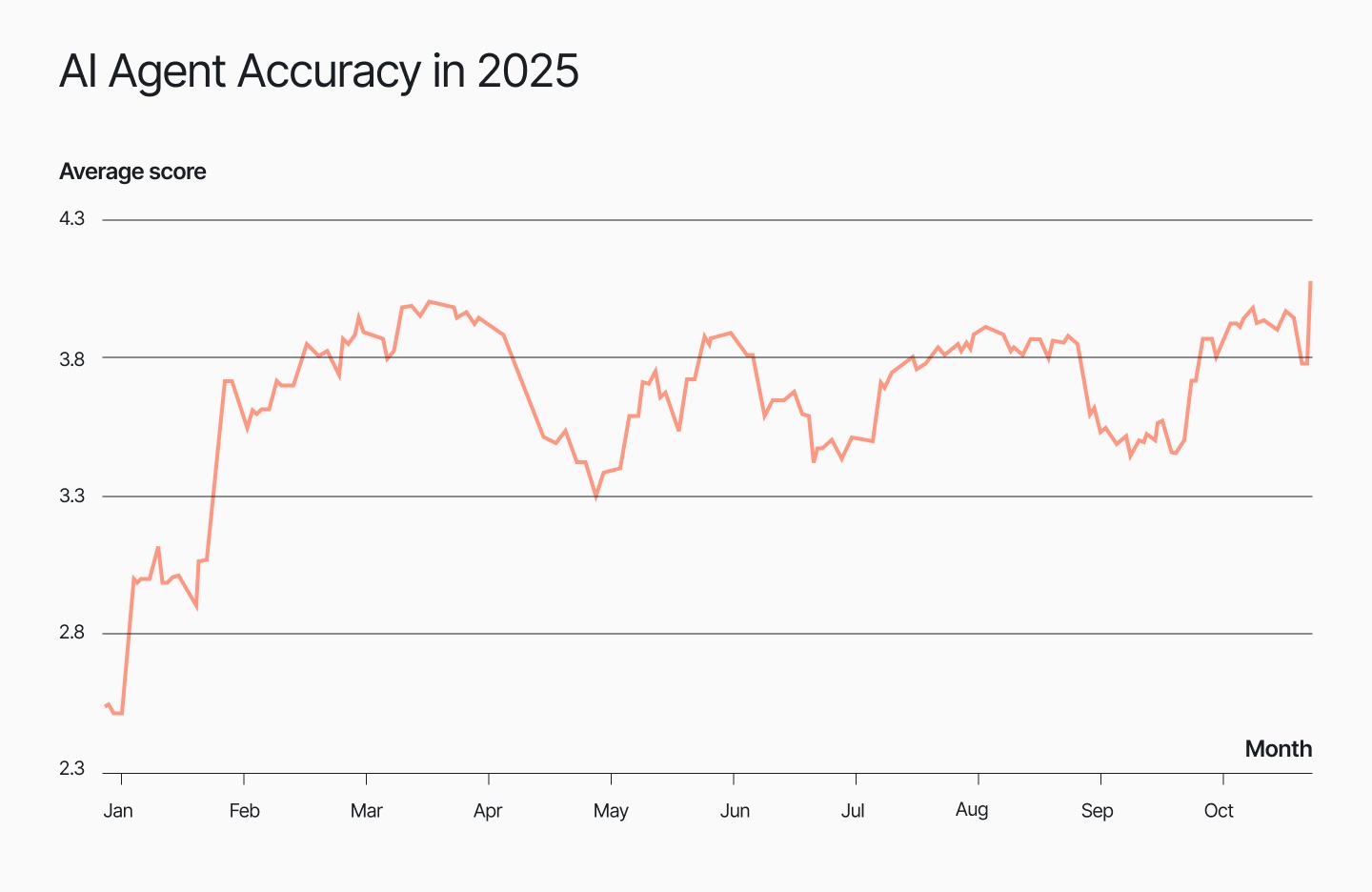
In the past year, we’ve improved knowledge retrieval, added new integrations, expanded reporting features, and asked for more feedback in-product.
We saw the steadiest leap in July, right after the release of GPT-5. AI Agent began reaching levels of consistency and accuracy that agents could trust.
AI Agent writes with more linguistic precision than humans
Clear, easy-to-understand language helps people trust what they’re reading. Website Planet found that 85% more visitors bounced from a page when typos were present. That’s why we’ve made it a priority for AI Agent to respond to customers with correct grammar, syntax, and tone of voice.
The efforts have paid off: AI Agent scores a high 4.77 out of 5 in language proficiency compared to 4.4 for human agents. The result is error-free messages that are easy to read and consistent with your brand vocabulary.
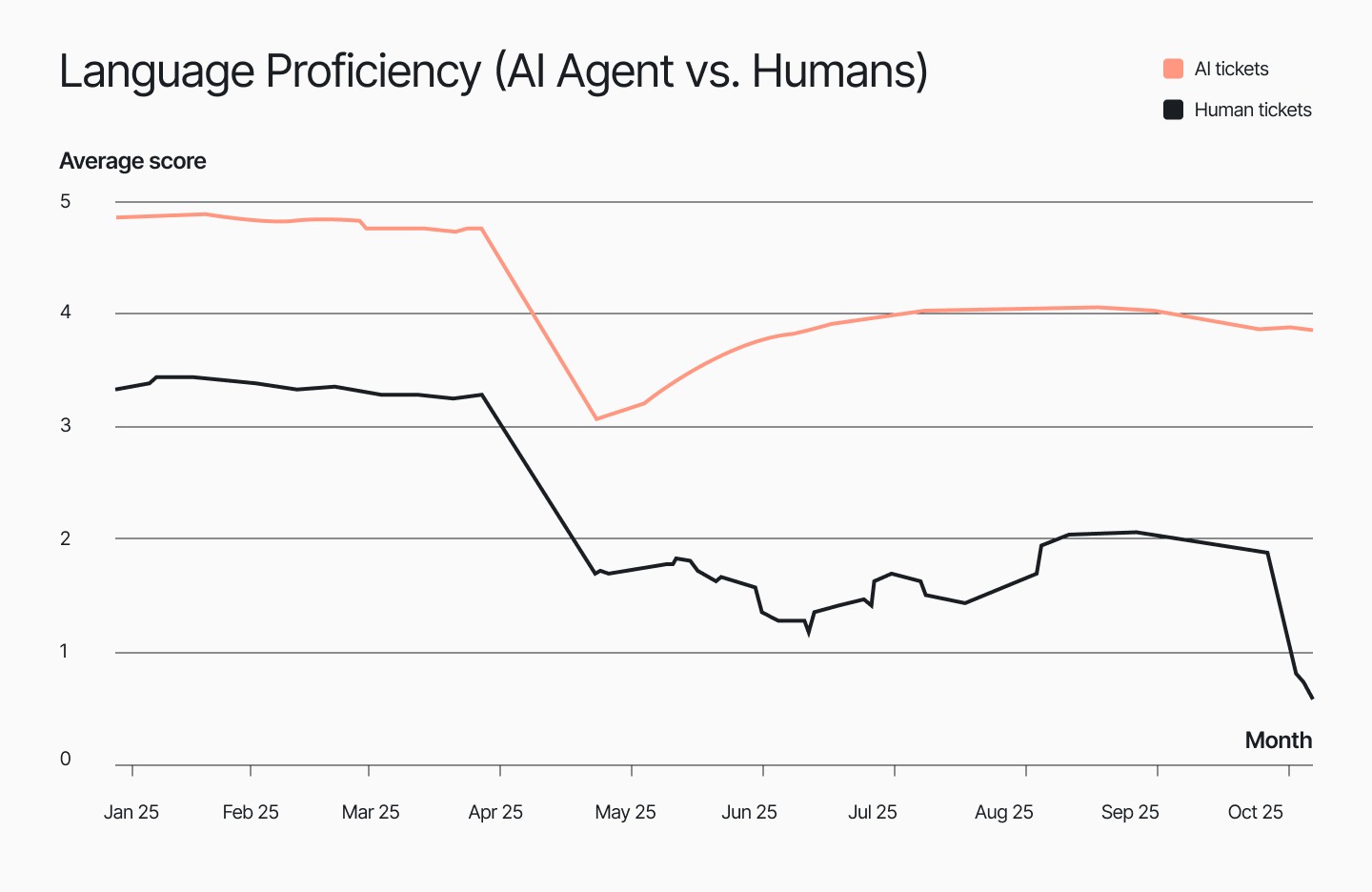
AI Agent shows that empathy can be scaled
Accuracy isn’t just about saying the right thing; it’s also about how a message lands. For that reason, we track AI Agent’s communication quality. Did it reply with empathy? Did it exhibit active listening and respond with clear phrasing?
Recently, AI Agent is even scoring slightly above humans with 4.48 out of 5 in communication, compared to 4.27. This means AI Agent captures the nuance of every message by considering the background context and acknowledging customer frustration before it gives customers a solution.
AI Agent resolves every part of a customer’s question
What happens when a ticket ends without a clear answer? Customers feel neglected and leave the chat still unsure. This can make your brand look out of touch, leaving customers with the lingering feeling that you don’t care.
But don’t worry, we built AI Agent to close that loop every time: AI Agent’s resolution completeness score sits at a perfect 1 out of 1, compared to 0.99 out of 1 for human agents.
In practice, this means customers feel cared for and understood, while your team receives fewer follow-ups, giving them more time to focus on strategic, high-priority tasks.
Read more: A guide to resolution time: How to measure and lower it
Brand confidence is on the rise
Building a great product is a two-way conversation between our engineers and the people who use it. We listen, review feedback, ship changes, and measure what improves.
From January to November 2025, AI Agent quality rose from about 57% to 85%. August was the first big step up, and September kept climbing. Brands are seeing fewer low-quality or incorrect answers and more steady decisions.
This is proof that merchants and their shoppers are witnessing the improvements we’ve been making, for the better.
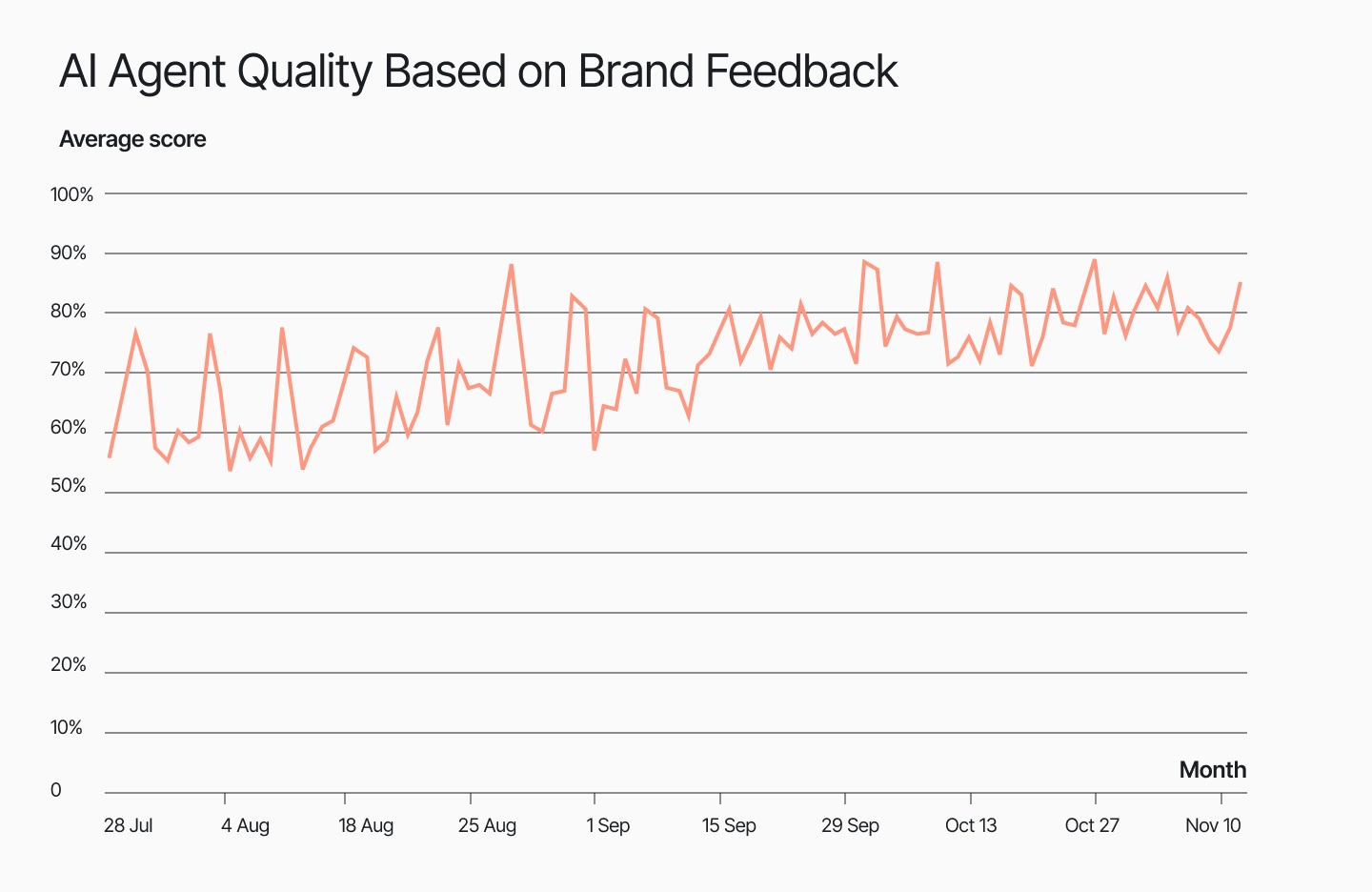
Related: The engineering work that keeps Gorgias running smoothly
Shoppers are rating AI support almost as high as human support
At the end of the day, what matters is how customers feel when they talk to support. Do they trust the answer? Do they find it helpful? Are they running into more friction with AI than without it?
Our data shows that customers are appreciating AI assistance more and more. Since the start of 2025, AI Agent on live chat has gotten a CSAT score 40% closer to the average CSAT of human agents. For email, the gap has narrowed by about 8%.
The goal is to eventually achieve a gap of zero. At this point, AI’s support quality is indistinguishable from that of humans. To get there, we’re focusing on practical improvements like accuracy, clear language, complete answers, and better handoff rules.

How we measure CSAT gap: The CSAT gap is calculated by subtracting AI CSAT from human CSAT. When the number is closer to zero, AI is catching up. When it’s negative, AI is still below human results.
Reliable AI interactions start with accuracy
Behind every accurate AI reply is a team that cares about the details. AI Agent doesn’t make up answers—it follows what you teach it. The more effort your team puts into maintaining an up-to-date Help Center and Guidance, the better the customer experience becomes.
As we look ahead to 2026, we’re focused on fine-tuning knowledge retrieval logic, refining Guidance rules, and continuously learning from feedback from you and your customers.
We’re proud of the strides AI Agent continues to make, and can’t wait for more brands to experience the accuracy for themselves.
Want to see how AI Agent delivers exceptional accuracy without sacrificing speed? Book a demo or start a trial today.
{{lead-magnet-2}}

AI in CX Webinar Recap: Turning AI Implementation into Team Alignment
Further reading

How to Calculate the Marginal Cost of Customer Service
And the Margin that Customer Service Impacts Your Net Profit.
In, The State of the Ecommerce Customer Service Industry Report for 2019, we found that a surprising 79% of respondents do not know the cost of a support ticket on the company.
This is quite scary, as this metric helps define the overall profitability of the product, and set reinvestment schedules for the growth of your company.
If costs overtake margin, you lose money with every sale.
While the Gorgias mission is to turn customer service from a cost center into a revenue generator, we do need to acknowledge the raw costs of customer support in order to bake it into our calculation of margin.
What metrics are we going to cover:
- Cost per support ticket.
- Cost per order.
- Cost per revenue.
Why should you track these metric?
- It helps baseline your opportunity for growth and profitability.
- You can make concerted efforts to lower your cost with customer service improvements.
- You can track indicators that something is going wrong with your business, and may require extra attention from the Head of Ecommerce or COO.
- You can hold your head of customer service accountable for staying within appropriate margins, and incentivize them accordingly.
Now, let’s get into it…
Step 1: Calculate your Cost Per Ticket
Here’s the data you need to collect:
Total cost of customer service. This includes technology, employees, managers, office space, equipment, travel… Everything. This should be easy to calculate if your accounting department is doing their job; they should be able to just hand you over a number. A monthly breakdown of the trailing 12 months is best.
Tickets per month. This can be found in your Gorgias dashboard under “Statistics.
Be sure to set the dates to match appropriately:

Now that we have these two numbers, we can get an understanding of our cost per support ticket.
Simply divide: In this example, we’ve got 1651 tickets in December. We spent ~$4500 on customer service. Therefore each ticket costs us $2.73.
Knowing your average cost per ticket helps you understand the time and value behind resolving customer inquiries. If this number goes up, then you’re inquiries are getting more complex - its either taking more time or more people to answer the same number of questions.
If you ever see this number spike, it’s likely due to a flaw in your product design. Immediately begin looking for commonalities among tickets, inspecting your inventory, and trying to get to the root of the problem before you make even more customers unhappy.
Step 2: Calculate Your Support Cost Per Order
Next up, you need to know your support cost per order, in order to bake customer support into your margin.
Here’s the data you need to collect:
- Orders per month.
To find this, simply log in to your Shopify dashboard, go to Orders, and add in a couple filters:

You can then “select all” and it will tell you the count of orders. For additional accuracy, you may want completed orders, not including refunds or other issues.
For our example month, we placed 2621 orders. That gives us a cost per order of $1.73
According to our Ecommerce Customer Service data, we estimate that small stores will see 88 support tickets per 100 orders, or roughly 1.1 support tickets for every $100 in revenue.
While large stores, with over $500k revenue/month, will see only 56 support tickets per month and .4 support tickets per every $100 in revenue.
How does your support cost per order compare with these benchmarks? Let us know in the comments below.
Calculate Your Cost Per Revenue
Sometimes it's helpful to calculate your cost per revenue as well, which is simply grabbing your net sales number from Shopify and dividing by tickets.
Data you need to collect:
Revenue.
Step 3: Consult with COO / Head of Ecommerce
You were previously calculating your margin without including the cost of support…
Even though support drives customer satisfaction, retention, and, in some cases, sales, it also has a clear impact on margin.
How does this new metric affect your COGS? Your margin?
If your average order value is $50, with a $13 margin, you now have only a $11.27 margin.
How does that affect your advertising objectives?
How does it affect your ability to invest into product research?
What can you do to improve your cost per order?
A lot. Mostly, this is called: ticket mitigation.
Here’s some of the more common opportunities:
- Updating your FAQ page.
- Improving your product detail pages.
- Video explainers.
- Onboarding videos.
- Educational retargeting campaigns,
- Stricter / more clear checkout processes.
- Improved notification emails to users.
- Faster shipping.
- Implementing new channels like SMS, on-site chat, or phone.
Final Thoughts
When you hire a new support agent, or manager, you will see your costs go up.
This is the nature of business: you’re investing in a new hire with the expectation that there will be more demand for them to fulfil.
You’re job, as an operations manager, head of Ecommerce, or COO, is to make sure those costs don’t get out of control while you look to scale your business.
Figure out what margins are acceptable to you and invest in growth cautiously. We’ve seen all too many companies fail because they oversupply and hit stretches of low demand.
That being said, if the business has healthy cashflow, and reasonable growth, I’d invest more in customer service before upping my ad budget.
It takes time to onboard new agents, and if you don’t have someone matching that demand, you’re creating unhappy customers, which is a surefire way to eat your margins even faster.

3 Ways to Reduce the Load On Your Customer Support Team
By Ross Beyeler, Founder and CEO of Growth Spark
Often, a support team answers the same questions over and over…
Or issues returns repeatedly for reasons that could be addressed internally…
Maybe the sizing isn’t well represented, the fulfillment house has mixed up SKUs, or your product images aren’t clear or detailed enough.
If you can lighten the load for your customer support team, you can save significant time and costs, while at the same time improving the buying experience for your customers.
The goals here are to:
- Reduce repeat inquiries
- Shorten first response times
- Speed up problem resolution time
- Lower overall customer care costs
The key is to address your customers questions and issues before they ask your support team. Here's how you do that:
A Better FAQ Page
91% of shoppers would gladly try to answer their own questions first using an online knowledge base or FAQ page before reaching out to a customer service team, according to a survey by Coleman Parkes for Amdocs.
This means that your FAQ page is a huge opportunity to answer your customers’ most common questions and issues so they don’t need to reach out to customer support.
FAQ information typically falls into one of two distinct buckets: product-specific and buying process.
Product Specific: Common questions about individual products may be better off addressed on the product pages rather than in a broad FAQ page. You may need to provide clearer or more comprehensive product descriptions, or consider more or better photography to clear up common product questions.
Buying Process: Questions about shipping, returns, policies, and other operational topics are best addressed in a single easy-to-find page like an FAQ.
When is the last time you cross-checked the content of your FAQ page with the data from your customer support team?
There are many customer support tools like Gorgias that will make it easy for you to track the reasons behind why users submit a ticket.
Once you begin tracking the topic, or tag, of your questions, you can easily identify the questions that top the list, and permanently add the responses to the FAQ.
Bonus points: Prioritize the FAQ page based on the frequency of each customer service inquiry so that the most relevant answers are closer to the top.
Your next step is to set up a monthly meeting with your head of customer service to review the feedback coming in from your customers and ask yourself:
- What are the most frequent topics of support inquiries?
- What issues take up the majority of your support team’s time and resources?
- What issues are emerging or could emerge do to seasonality or new initiatives within our company?
Remember, an FAQ page is:
- Easy to find
- If shoppers can’t find it quickly and easily, they won’t use it and all your work answering all of their questions will go to waste. If you have an answer on your FAQ page, yet people are still inquiring, they might be having trouble finding the page.
- Searchable
- Include a search bar so that shoppers can easily find the answers for their specific problem without having to read through everything else.
- Easy to read
- Use simple, conversational language. Technical slang gives most of us a headache, and leaves most people reaching for the closest live human to explain it in terms they understand.
For more on FAQ pages, check out this Shopify article.
Now that you have your FAQ page squared away, be sure to track visitors to the page and note any changes in volume, and look for changes in your support ticket volume around those related questions.
Remember: You should never answer a support ticket only by referencing your FAQ page. Always include the information they are asking for directly within your response. After that, let the customer know that there is an FAQ page for more information, to avoid future tickets.
See Where Your Customers Get Tripped Up
Have you watched actual customers explore your online store to see where they stumble?
Customer behavior tools like Hotjar make it easy to review how customers navigate your website. One way that customer behavior analysis tools can help you understand exactly how your customers are using your site is with heat maps.
 |
A heat map is a visual representation of the most popular (hot) and unpopular (cold) elements of a website page. They can give you an at-a-glance understanding of how people interact with individual website pages. Elements that get the most views and interaction are shown in red, so you can immediately spot what your users are clicking on. Those that most people tend to ignore appear in blue.
Once you know which parts of your website are most (and least) useful to shoppers, you can tweak those elements to make the on-site experience easier to use.
Customer behavior data can inform on-site improvements, such as:
- Identifying any “dead” pages so you can remove them
- Recognizing “deep” content that requires too many clicks for customers to reach, and making it more visible or accessible
- Ensuring that customers can easily see and access main links, buttons, and CTAs
- Making sure that important elements are getting the attention they deserve
- Checking whether any static elements are getting clicked too often, and adjusting them to clarify that they aren’t a linked object
It may require some A/B testing to ensure your changes deliver results.
Learn from Returns
According to a recent Shopify post, during the holiday season, Ecommerce returns surge to 30 percent (or as high as 50 percent for “expensive” products).
Return deliveries are estimated to exceed $550 billion by 2020 in the U.S. alone.
Many of those returns are probably associated with a customer support ticket - whether customers are asking questions about the product they received, or need help processing their return.
Anything you can do to reduce the number of returns - and the number of customer support requests associated with them - can mean a huge boost for your bottom line.
So, what causes returns?
Returns can often be traced back to a disconnect between customer expectations and the reality of the product once they receive it. It may be that:
- It doesn’t fit the way they expected
- It doesn’t look or feel like they thought it would
- Delivery came later than they expected (or not at all)
All of these problems (and more) can be prevented in advance with improvements to your website content.
Sizing Issues
While fit can be a difficult factor to get right online, including detailed dimensions is a big step in the right direction. Some apparel merchants are taking sizing one step further with interactive fit guides, like the one above Nudie Jeans, which uses an app integration called Virtusize:.
 |
Appearance Issues
Poor quality or not enough product images can make it difficult for customers to accurately understand what your product will look like when it arrives at their home.
You can easily reduce your return rate by making sure your product photography is clear and high-quality, and illustrates all of the primary parts of each product. More complicated or detailed products can also benefit from a video or 360-view.
Detailed product descriptions can also help address confusion about product appearance and feel. Sol de Janeiro does this with a multi-tab product content area that defaults to a brief product highlight, with additional tabs to provide more details.
 |
Fulfillment Issues
Are orders not being fulfilled to the right customers?
Are deliveries taking longer than they should?
Analyzing your fulfillment data and using that information to make adjustments to your website content - such as average delivery times - can help eliminate a source of customer support calls.
 |
For example, maybe you want to be able to deliver every order within two days, but your current fulfillment resources simply can’t make that happen consistently. Being up-front and clear about realistic delivery times (like The Black Dog does in their Shipping FAQ page, above) will help set customers’ expectations appropriately.
Bonus: To get setup on two day shipping, consider our partners at ShipBob.
Final Thoughts
Continue to study your on-site data using Google Analytics or Shopify’s native analytics and look for high exit % pages. These may be pages where prospects or customers are running into a dead end and being forced to turn to support.
You can also create a goal in Google Analytics that corresponds to contacting support, then reverse the user path to determine which pages lead to them submitting a ticket / hitting that “contact” or “support” button.
Chances are, there are a few areas of “low hanging fruit” that can make significant improvements to your customer support load once you find them and address the root concerns. And with those small fixes, you could see a big impact on your bottom line, and a better on-site experience for your customers.
Read more about customer support on our trusted partner’s site, Growth Spark:

Customer Loyalty: Bringing The Human Touch Back To Ecommerce
Ecommerce has become awash with digital bells and whistles. Technology has no doubt enhanced the shopper experience but the rapid rate of digital innovation has had a profound effect on customer expectations. By 2020, customers expect brands to automatically personalize experiences to address (not just predict) their current – and future – needs.
But, although customers expect more in terms of tech, they still crave the person-to-person connection. In fact, 75% of consumers want to see more human interaction, not less.
At LoyaltyLion we know that bringing back this human-touch depends on providing a good customer experience. Clearly, a worthwhile cause, as studies show that 86% of shoppers who received great customer care are more likely to repeat purchase. By going the extra mile to treat your shoppers as people – rather than numbers – you can secure a faithful, constant customer base.
Here are three insights that will help you bring the human touch back to your online store.
Use Data To Personalize Communications
Each customer is unique. They interact with your brand in different ways, all while having their own personal needs and desires. When a customer feels that you have taken the time to understand their unique requirements, they will trust and value your brand more.
Data and personalization go hand in hand. By using member information to learn how customers engage with your loyalty program, you can understand their feelings towards your brand and react accordingly. Being data-driven is the key to true e-commerce success.
One golden opportunity to personalize your communications this is through targeted emails. Use your Gorgias dashboard to identify past interactions and purchases, as well as a customer’s loyalty points balance. You can then use that member data to create bespoke rewards that you can send right to your customer’s inbox.
Maybe you’ve noticed that they keep eyeing a specific product range? If so, give them discounts on new products in that collection to tempt them to back to buy again. Or perhaps you’re aware that they’re just a couple of points away from their next reward. Give them a little nudge to return and receive their reward sooner. For example, LoyaltyLion user Dr. Axe alerts customers when they have rewards waiting to be claimed, and suggests a particular product to redeem that reward on.

Find Ways To Delight Customers
Shoppers love to feel that they’re your only priority and that you care about them on a personal level. They want to feel valued as individuals, not just another number in an extensive database.
Loyalty strategies should incorporate ways to surprise and delight customers. For example, making it easy to offer customers points on their birthday or taking a moment to personally congratulate them when they’ve made a certain number of purchases with you. Beauty Bakerie, for example, offers their customers 500 points on their birthday.

With Connectors for Shopify Flow, it’s easy to use LoyaltyLion and Gorgias to set up triggers that automatically create tickets on a customer’s birthday, reminding a representative to get in touch. It’s the thought that counts and going the extra mile will ensure your customers trust and remember you. Plus, you’ll feel good about it too!
Convert Negative Experiences Into Positive Ones
Customers get frustrated when they feel their complaints aren’t taken seriously. Dissatisfied customers will tell between nine and 15 people if they have a bad brand experience. Using Gorgias’ helpdesk and macros, you can help resolve complaints whilst maintaining a personal touch. For example, ethical online yarn store, Darn Good Yarn uses the helpdesk to analyse and automate how they solve common customer issues, using a whole database of the shopper’s history to address specific queries in a more informed way.
If you are reacting to customers have had a negative experience, your loyalty program can help you demonstrate you care. You might consider offering bonus points or benefits such as free delivery, or moving them up a loyalty tier so that they can unlock more exclusive rewards in the future. These tokens of appreciation can turn a bitter experience into a sweet deal.

Research shows that 94% of customers who have their issues solved painlessly said they would purchase from that company again. This shows that helping customers to solve their problems is key to securing their long-term loyalty. Treat your most valuable customers well by making their shopping experiences as easy as possible. In return, they’ll give you their loyalty.
It’s all about people-to-people
In a world where technology and data can give ecommerce stores a competitive edge, there’s a risk that we could lose touch with the human side of retailing. Human exchanges are still, and always will be, the primary driver of loyalty. So, use digital personalization to your advantage and treat your customers as individuals.

Small engineering team as a competitive advantage
It's been over 3 years since we've started working on the Gorgias helpdesk. The engineering team started with just me (Alex) and then gradually grew to a team of 5 people. We're a small team, but we've accomplished a lot during this period. Here are some stats from 0 code/customers/revenue in Oct 2015 to this:
- Handled over 16 million tickets.
- 2000 daily active sessions with an average length of ~4h each.
- 600 paying customers (companies).
- 17% MoM revenue growth.
Modest numbers to be sure, but we're very proud that people use our product in a big part of their workday and hopefully are becoming more productive while doing so. The whole idea behind our product is to scale customer support with as little resources as possible. Given this, perhaps it's only natural to build our product with a small team as well?

We've been suffering chronically from "not having enough people" - we still do. That forced us to adopt a certain engineering culture that I want to talk about in this post.
When we first started building Gorgias, having just a few people on the team allowed us to progress at a pace where we could collect real feedback from our customers with things that really mattered to them rather than building every feature they ask for. A lot of their asks seemed legitimate, but because we didn't have a lot of people it forced us to prioritize the critical, high impact things first.
Having a small team can act like a barrier that blocks you from building a bloated product.
I want to make more of a case for the above statement, but first I'd like to get a bit more into what we did during the 3 year period.
Once we've build an initial version of the app and got our first customers we quickly realized that building a "second Gmail" is super-hard:
- Communication protocols (email/facebook/etc..) are complicated - we knew that before we even started, but it's difficult to describe the amount of work that needs to get done to make them work correctly. The amount of corner cases and weird protocol quirks is just staggering. In fact I would even go ahead and say that if you're integrating with any kind of external systems (webhooks, REST apis, etc..) then you're going to have a very hard time making them work correctly.
- Having a highly-available and fast app is very hard when you don't have a team of full-time SREs. Scalability was not our big concern when we first started because we didn't have customers, but having an app that was always on was very important, remember the ~4h average session length? It meant that we had to make some architecture and infrastructure decisions that allowed for a high uptime.
- Customer support software space has a very high barrier for entry these days. You need to have certain features before people start to even consider you as a platform. The switching costs are high as well because now you have to train your people on a new app and changing people's routine is hard.
It takes a lot of effort to get to a point where you can compete with the likes of Gmail or Zendesk - both amazing products btw. This was definitely the case for us, for close to 2 years we had only a couple of customers and our product wasn't that good if we're being honest.
So what changed a year ago? To put it simply: our product didn't suck anymore. Or sucked less. It had that minimum set of features and stability that made it attractive enough to our main customer base (Shopify merchants) that were passionate about productivity in the customer support space. That, and the tenacity of our CEO Romain who was convincing everyone that they should use us.
So we started having our second wave of early adopters and all our hard work was finally starting to pay-off!
Now that we had more and bigger customers we were starting to have performance issues, our app was slow, suddenly we were starting to get bombarded by viral facebook posts events or promotional events via an email campaigns, we didn't have enough monitoring in place, our app was pretty inefficient, the main database was a frequent source of congestion. So we started fixing those issues while still receiving numerous feature requests.
Thankfully we didn't actually optimize our code that much before (no customers!) and there were a lot of low hanging fruits at first, but it still put a lot of stress on the team which was becoming tired and overworked and requested to hire more people to build those features and help with the performance issues.
We all agreed that it would be for the best to have more people on the team, but hiring is hard. Competent coders are not just randomly looking for the next gig. SF is also a very expensive city and for a startup that raised $1.5M and a 2 years of money burned we couldn't really compete with other players in town. We've started working with some great devs in Europe, we worked with a few talented interns as well and we tried to get by until we could have more customers and hopefully raise some more money to hire more people.
I could speak more about hiring in the Bay Area and there are a lot of things we did wrong and still have a lot of things to learn, but that's probably an even longer post than this one. But yeah, it's hard to find someone good, it's expensive, etc...
So what is the situation right now? Well, it's not much better. We've raise d a seed extension round from SaaStr with Jason Lemkin and hired a few people in the Growth team, but we still have a hard time hiring in SF or remote. In the meantime we have a small team and want to talk about that.
On the importance of saying NO
I think it's important to realize the advantages of having a smaller team and the single most important super-powers that you're forced to acquire is saying NO more often that you would with a bigger team. If you have a bigger team and say no to a feature, new platform, integration, etc.. it's harder to justify the decision. There are arguments like:
... we have enough devs! They are paid to make features, so what's the problem!?
... the data shows that 50% of our customers are saying that they want this or that feature, we must build it!
But do we absolutely need to build that feature? Are the customers going to be a lot less effective with your product otherwise? Is it going to be a big boost for them or just a nice improvement? Once a feature is there you have to maintain it, fix bugs, improve it, etc.. The thing with data driven decisions is that sometimes it can be biased towards some historical practice that might not have a place in your current world.
Now, I'm not saying that you shouldn't listen to your customers, you absolutely have to, but be sure you understand well what they want before taking action and understanding takes time. Having an artificial brake on your enthusiasm might be a good thing.
Engineers build things, the natural tendency is to accept any technical challenge because of ego, curiosity, fun, etc... It takes discipline to say no and stick by it. A small team is making it easier to do it.
Automation
When you have a small team you're forced to automate a lot more often some of your workflows. You don't have the luxury to do repetitive stuff so:
- You start writing more tests because you don't have people hired in QA and you don't want to repeat the same tests all the time.
- You add optional static typing, linting and other code quality tools because you don't have time to deal with random type errors or have debates about tabs vs spaces.
- You resolve repetitive bugs by doing some refactoring because you can't deal with the constant flow of tech support tickets.
- You make a lot of tasks retry-able so if a HTTP request to facebook failed you don't have to manually retry them.
- Cronjobs, cronjobs everywhere.
Building the right culture is a long process
People that work at Gorgias come from different backgrounds and sometimes it can be challenging to be on the same page. In some cases our work processes are similar to many other companies:
- Github for our code and issues.
- Code-reviews on Reviewable - it's awesome!
- Jenkins to build our docker images and upload them to google cloud.
- Kubernetes to run everything on GKE.
- Sentry to collect production errors.
- Datadog to monitor everything.
But there is so much more than just the above processes to engineering:
- The way we all come together and decide how certain things will be built or fixed.
- The way we talk about a certain API decisions and refactoring.
- The way we deal with an outage and a bad bug that affects our biggest customers.
These things need time to happen to be embedded in your engineering consciousness and if you're the first-time founder (like myself) you also need the time to understand how to operate in this environment.
Management overhead
Never managed a big team so I can't really speak about it's dynamics, but I would expect that because there are more people there is a lot more bandwidth you have to manage, a lot more people have to agree, a lot more politics have to be settled. I don't look forward to that to be honest, the more time I can get away with hiring as little as possible without a big sacrifice of our growth as a company the more I'll try to delay it.
I conclusion I would say that it's totally fine to have a small team, in fact, I'm considering it a competitive advantage that you should try to keep as long as you can.
The irony
I made a point in this post that having a small team is a competitive advantage, but I also think that we are ready to grow our team a bit. Yep, we're hiring!

Scale your Messenger marketing with Octane AI and Gorgias
Facebook Messenger is becoming a new marketing channels for brands. They use it as a way to build personal relationships with customers and to drive higher conversion than traditional email marketing.
Today, we're excited to announce our newest integration: Octane AI.
The challenge with Messenger marketing
When a brand launches a marketing campaigns on Messenger, it typically leads to insane conversion rates. That's why the trend is on the rise.
Another consequence is that a lot of customers respond to promotional Messenger communication. This generates a spike of support requests, that your support team has to deal with.
Our integration with Octane AI lets you handle this support spike directly in Gorgias. Your agents have context about the customer: they see the conversation history before the Messenger conversation (did the customer email you last night?), and allow you to take action, like editing or refunding an order
What you can do with the integration
- Respond to requests from customers, to make sure none of them falls through the cracks
- See the order data from Shopify next to your Messenger conversations
- Automatically respond to common questions, such as "where is my order"
Customers are already using Octane AI and Gorgias. Here's what Live Love Polish has to say about the Octane AI and Gorgias integration:
“We’re really thrilled that Gorgias and Octane AI came together to make the customer service experience over Messenger even better for our customers. Accessible customer service is central to what we do at Live Love Polish. Answering customer questions via Messenger has made our customers happier.”
Do you want to give this a shot? If you use both tools, just connect your Facebook page to your Gorgias account and see the magic happen. If not, create a Gorgias account, or sign up for Octane AI.
Do you have questions? Just hit the chat bubble, our team would love to tell you more about the integration!

Integrate your Smile.io account to Gorgias!
Loyalty programs are widely used amongst e-commerce merchants to grow and maintain market share by improving the number of repeat customers and attracting new ones. These programs come in different formats - from loyalty points to surprise gifts depending on the level of loyalty of each customer - and have proven efficient to help brands build a community of consumers based on the emotional attachment to their identity and values.
As a customer support helpdesk, Gorgias is focused on providing the best experience for both end-consumers and support agents. Consequently, giving access to the most accurate information about your customers’ loyalty status enables your support team to adapt their answers to customer requests.
Thus, it seemed only natural that we partner with Smile.io, a rewards platform that has helped over 20,000 merchants reward their most loyal customers for performing profitable actions.
With Smile, you can create and manage reward programs such as loyalty points, referrals and VIP programs, to build a fruitful relationship with your customers.
Because Gorgias is appreciated for its ease of use and automation tools, we have decided to build a strong integration with Smile: not only can your support team have easy access to all the necessary data about your customers, but they can also use Smile variables in canned responses (or “macros”) and automation rules.
- Display your customers’ Smile profiles next to tickets

- Use Smile variables (loyalty status, points balance, VIP program, referral url) in both your macros and your rules

By integrating your Smile account to Gorgias, you’ll be able to improve yet again not only your customer support but also your customers’ engagement to your brand. Our early adopters of the integration are already thrilled by it!
"We're loving the Smile integration so far! Having access to the variables in the automation features of Gorgias (macros and rules) is a game-changer, especially now that we're focusing on improving our loyalty program. It would be great if the integration went a little further in the future to enable editing loyalty points!"
Chris Storey, Founder and CEO at Dinkydoo
If you're already a Gorgias customer, you can connect Smile directly from your Gorgias account, in the Integrations section. If not, you can create an account here and get started in a few minutes.

Announcing the Okendo integration
Here at Gorgias, our aim is to provide the best customer support tools to our clients, whatever their specific needs. The more you grow, the more we work to develop our offer so that you can benefit from a tailor-made spectrum of integrations. As your business becomes more successful, you need to adapt your website to a fast-growing community of consumers, especially regarding the quality of your reviews and how they appear.
This is why today we are proud to announce our new partnership with Okendo, a customer-marketing platform perfectly suited for high-performance Shopify businesses.
Okendo helps Shopify’s fastest growing companies like oVertone, Paul Evans and Dormify build vibrant customer communities through product ratings & reviews, customer photos/videos and Q&A.
Along with this, Okendo gives you the tools to leverage customer generated content across other marketing channels such as Google Search, Google Shopping, Facebook and Instagram.
Since one of the key advantages of using Gorgias is to manage all your customer support in one dashboard, we decided to design a straight-to-the-point integration:
If a customer leaves low rating review such as < 3 stars and/or with negative sentiment, Okendo can automatically create a ticket in Gorgias. This way, your staff can quickly engage in a conversation with them to understand what went wrong, and address the issue immediately.

We believe this integration will take your customer support teams to the next level, as Okendo has already convinced some of our key clients.
"One of our biggest assets is our unique customer community, so being able to maintain it as active and engaged as possible is key for our business. And making sure that we address any negative experience efficiently and in no time is just as important: this is exactly what the Okendo integration within Gorgias has enabled us to do, by automatically creating a ticket for these cases with the review displayed right next to it."
Dan Appelstein, Founder & CEO at BeGummy
"Aside from being excellent at building shopper trust, reviews enable us to identify customers who, for whatever reason, have had a less than stellar experience. The Okendo + Gorgias integration enables us to flag these instances and automatically assign a Gorgias ticket to a member of our Client Services Team, so that we can follow up and do our best to assist them with whatever issues they're encountering. This integration, along with Okendo’s consistent availability and unwavering support, have made the integration between these two platforms seamless and successful!"
Jae Sutherland, Director of Client Service at oVertone
If you're already a Gorgias customer, we can introduce you to Okendo to implement the integration directly from your Okendo account. If not, you can create an account here and get started in a few minutes.

How Campus Protein built a multi-million dollar business
The supplement industry is not often the first thing that comes to mind when looking to start a new business. It’s crowded, the barriers to entry are low, the margins are thin, and there are some established and well-known brands with large budgets to outspend competitors.
And yet, Campus Protein, a provider of supplement to college students that started in a dorm room in 2010, has managed to carve itself a highly profitable niche and power its way to millions of dollars in revenue.
No, there’s no magic sauce or secret weapon that helped them do it. They have the same access to resources as everyone else. In fact, they have a smaller team than older brands in the space.
The only difference is they focused on one thing that others in the industry weren’t, the customer experience. This is the story of how they did that and dominated behemoths like GNC in colleges across the US.

Identifying The Problem
Before coming up with the idea, founder Russell Saks was just another sophomore at Indiana University. After joining a fraternity, his new friends convinced him to start hitting the gym.
As Russell started getting into fitness, he noticed that every month his friends would head to the local supplements store to purchase $200 to $300 worth of protein and workout drinks. These were the same people who always complained that they didn’t have beer money on the weekends. Yet here they were, spending hundreds of dollars on supplements without batting an eyelid.
In any industry as crowded as the supplement industry, there are always cheaper options. You can go online and buy your supplements at a much lower price than at the local store. However, the drawback is that you have to wait for it. And, as Russell found out, college students never planned ahead and always needed their next tub of protein powder instantly.
Ever the entrepreneur, Russell figured there was an opportunity here. If he could combine the affordability of online prices with the same-day delivery of the local store, he had a business. All he had to do was bulk order product from a low-cost site in advance, store it locally, and then redistribute it to students when they needed it.
As with any business, those initial days were rough. Yes, there was demand and Russell would often sell out each batch soon after they came in, but the margins were razor thin. To maintain cost-effectiveness, Russell sometimes had to take a loss on certain products.
On top of that, Russell found that his life was getting consumed by the fledgling business. To scale it up, he needed help. His friend and first business partner (now Chief Sales Officer), Mike Yewdell, was a fellow student at Indiana University with lots of connections. With his network, they quickly became the go-to source for supplements on campus.
Russell’s next stop was his high school friend (now business partner and CMO), Tarun Singh, who was studying in Boston University at the time. Tarun noticed the same problems at his school and quickly expanded Campus Protein to his school and then the entire Boston area.
The final piece fell into place when they entered into a business competition and won $100,000 to scale up. With the up-front money, they could negotiate deals with supplement makers to improve their margins, and expand to more college to increase sales.
Today, Campus Protein is in over 300 colleges across the US and shows no signs of slowing down. But none of that would have happened if Russell hadn’t been hyper-focused on a certain type of customer and their needs.

Customer Experience As A Growth Channel
One thing Russell learned early on was that college students had very specific needs. Thus, they craved a personalized experience. They needed help with what supplements to buy based on their goals and budget.
At the local supplement stores, Russell noticed that they couldn’t get any of that. Firstly, they sold to everyone so they didn’t have any expertise specific to the college student market. Secondly, they were trained to sell as much product as possible, so they’d often push supplements that weren’t right for the students.
Russell realized that Campus Protein needed to really understand the needs of a college student to own the market. That meant the company needed to hire students who were into fitness. And so the Campus Rep program was born.
A Campus Rep's main job is sales and marketing. They grow awareness for the brand and encourage help other students achieve their fitness goals.
By recruiting Reps in each college, Campus Protein could keep their core team lean while maintaining a large salesforce on the ground.
This has been the real key to their growth. These Reps are their ideal customers, and they hang out with other prospective customers. Thus, they provide a customer experience that’s far better than anything other brands can offer.
Imagine you’re a college student. Before Campus Protein came along, you had to figure out which products to buy, got pressured into buying unnecessary stuff, and ended up with very little money left over.
Today, you probably have a Campus Protein rep in your gym, wearing a branded tank. He’s giving out free tasters, providing you with workout tips and nutrition advice, listens to your goals, and hands you a card with a link where you can buy exactly what you need for much less. How’s that for customer experience?

Extending The Experience Online
Campus Protein may be marketing offline with their campus reps but all their sales come from their Shopify website. That’s the best way for them to scale.
Here’s how it works - they have warehouses across the country where they stock product. Because of their deep customer understanding, they know exactly what to stock and what not to stock. The campus reps then go around building awareness, and students head to the website to make their purchase. Because of the warehouse network, they get their products pretty quickly.
Because the actual sale is made online, the website becomes a crucial part of their strategy. If they don’t provide the same level of customer support and care their reps do, they’ll drop the ball and lose the sale. More importantly, they’ll lose trust. One bad experience could hurt their reputation across an entire college.
To replicate the one-on-one support of their reps, they used website chat. In the early days, they started with Zopim Chat. But as they grew, they found that it was too basic for their needs. They couldn’t tell if someone they were chatting with was an existing customer or a new one. They couldn’t tell if it was a new conversation or a continuation of one that happened in a different channel. It was a poor experience for the customer and the company.
Remember, they have a small core team, so they needed a customer support tool that could do the heavy lifting for them. That’s when they came across Gorgias and it allowed them to create an online experience that increased conversions and revenues.
For starters, Gorgias combines all their customer support channels (chat, email, phone, social media) into one unified view, and builds a profile of each customer. When a student chats with them, Campus Protein know if they are a previous customer, can see all past conversations and sales in their dashboard, and can provide relevant support.
Compare that to the typical support you get when you’re forced to repeat your previous conversations each time you chat with someone.

To speed things up, Gorgias also has macros and templated responses based on the question. For example, if a customer wants to know where their order is, Gorgias presents the support agent with a templated response that pulls in the customer’s order details from Shopify. With just a click, the support agent can answer the question in near real-time.
Automations like this also frees up time for support agents to provide more detailed answers to complicated questions, like when a student asks for nutrition advice. Again, they can provide the same level of caring support that reps do and this helps increase sales.
Another way they increase sales is by detecting if customers are spending a lot of time on a certain page and initiating a chat with them. For example, if someone is on the checkout for too long, Gorgias automatically pops a chat and ask them if they need help. This directly increases conversions.

Perhaps the most important way Campus Protein uses customer support to increase revenues is by converting feedback into website and product changes. For every question that comes in, they try to understand why it wasn’t obvious on the website, and make the appropriate change. This leads to fewer tickets of the same type and higher conversions.
Widening The Moat
At the end of the day, Campus Protein is just another retailer. In an industry like supplements, anyone can replicate their model, or existing brands like GNC can enter the market. So why hasn’t that happened yet?
Like Warren Buffett says, every business needs to have a moat, something that defends them against competition. In Campus Protein’s case, it’s their deep customer knowledge and the personal level of support they provide.
A college student is introduced to Campus Protein via the local rep. They’re nice, helpful, and remember the student’s name each time. When the student goes online, they have the same experience. Their previous conversations are remembered and even their most complicated questions are answered with care.
Now, you may not be able to create a rep army like Campus Protein for your eCommerce business, but you sure can create an online customer experience that sets you apart from others in your industry.
With Gorgias, whenever a customer creates a ticket on any channel, you have all their information like previous conversations and sales, right there. Instead of asking the customer if they’ve written in before or what their order numbers are, you can get straight to the important stuff. And with all the templates, macros, and automations available, you can do it in minutes.

When a customer has to decide between purchasing at a store where they forget about you after the sale, versus one where they treat you like a friend and remember you a year later, which do you think they’ll choose?
Give your customers a great experience and, like Campus Protein, you’ll have a business that keeps going up.
Curious about how Gorgias can optimize customer service? Click here to learn more.


Building delightful customer interactions starts in your inbox


